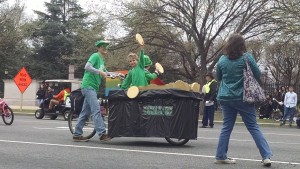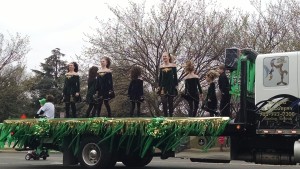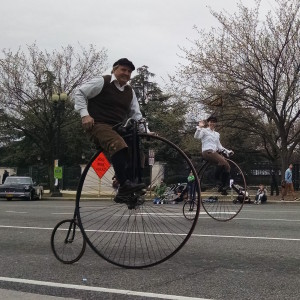Posted by barb on Nov 22, 2016 in
Pictures,
Recreation,
Travels Today was our only full day at Kwara. I didn’t mention, but Kwara is part of the Okavango Delta – a large inland delta formed by the Okavango River. The River ends at the Delta. This serves as a great water source for many of the animals in the surrounding areas. It’s a perfect place to visit during the dry season, because the animals congregate in this wetland.
As usual, we grabbed breakfast around the campfire – I tried the oatmeal-like hot cereal, and it was pretty good. Then we hopped in the safari truck and took off.
Our truck scared a group of birds as we took off down one of the roads.
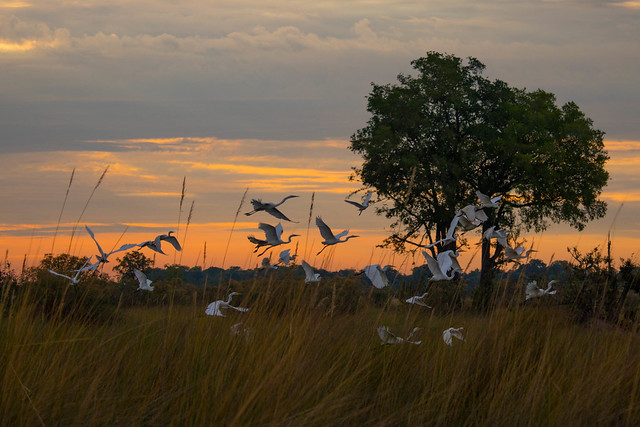
We also spied a group of waterbucks – their camouflage was actually quite good!

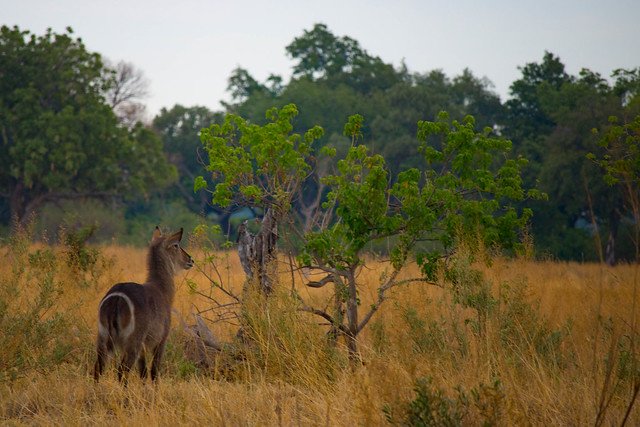
Then we came across this group of zebra. They look like a band or something.
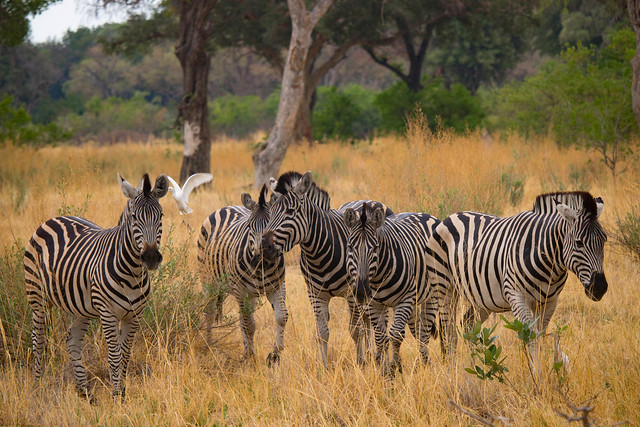
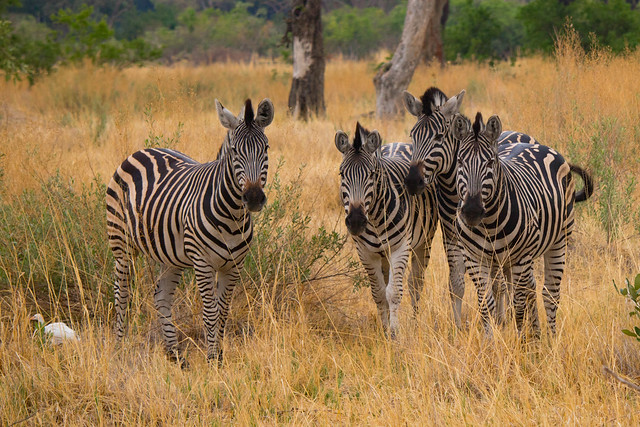
And I love how the cattle egrets follow them around. I know its a symbiotic relationship, but they look like besties.
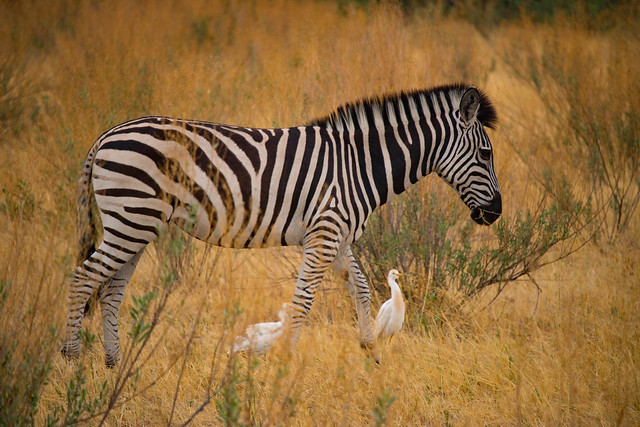
We also came across a few babies on the way – a baby wildebeest …

… and a baby tsessebe.
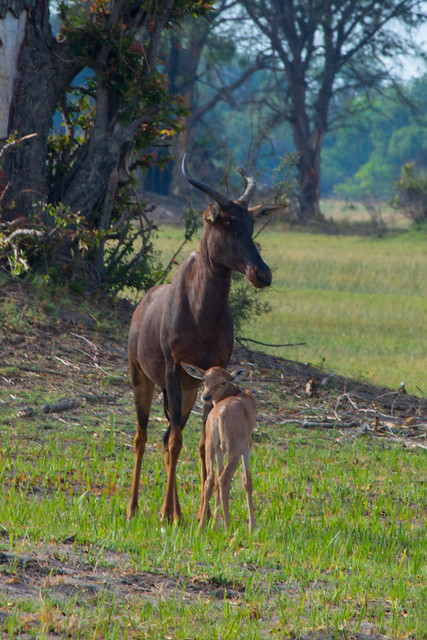
Before long we got a call from the other truck – their guide and tracker had found a cheetah in the area. We made our way over and saw this beauty. I took this picture to show how close our trucks came to the animals.
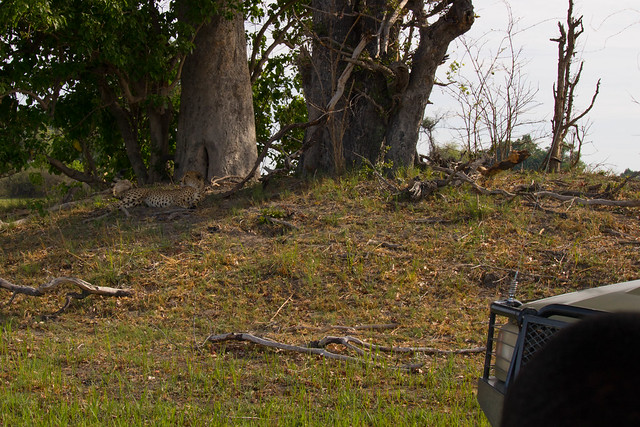
But here are the beauty shots.
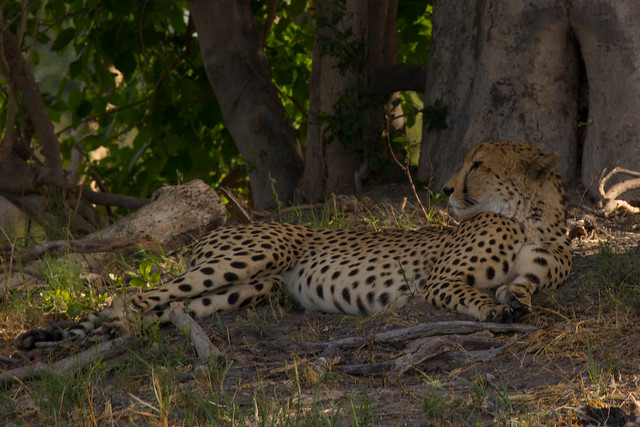
And then he rolled over.
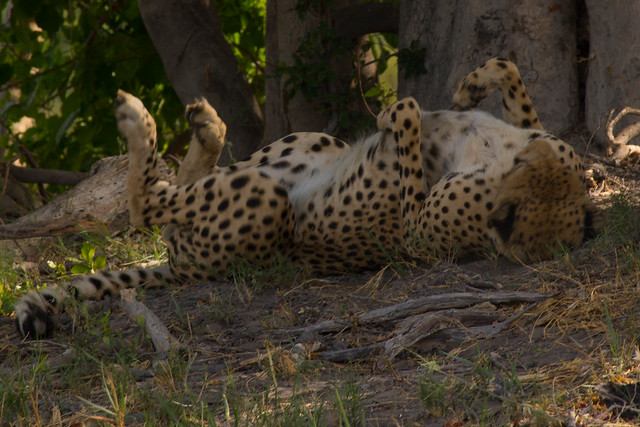
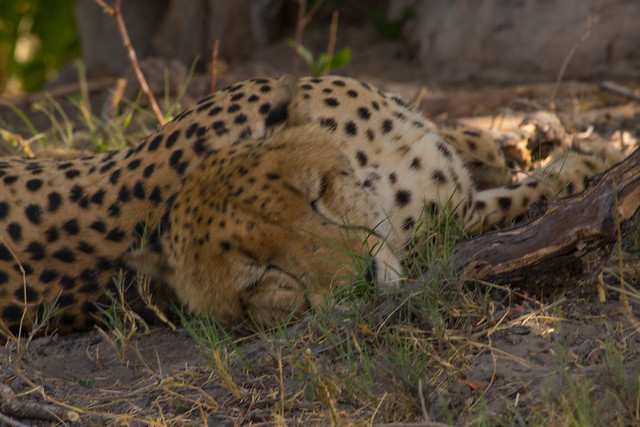
And then posed for the camera.
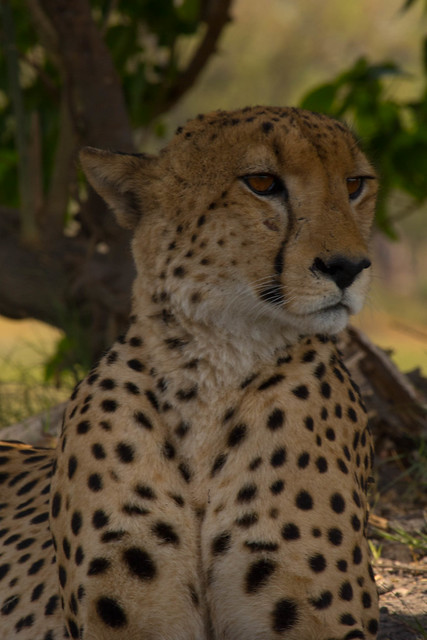
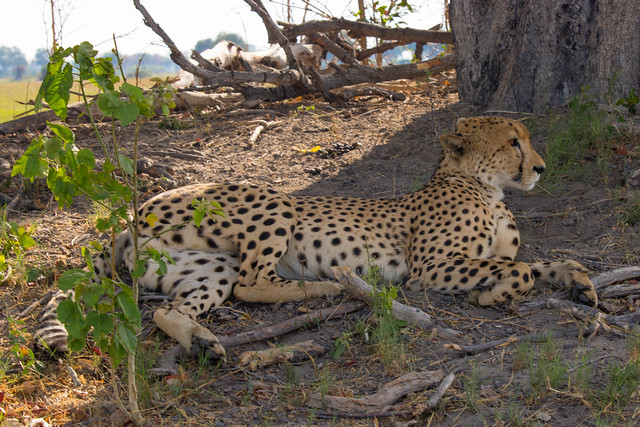
Then we moved on and found the pack of dogs just lounging.

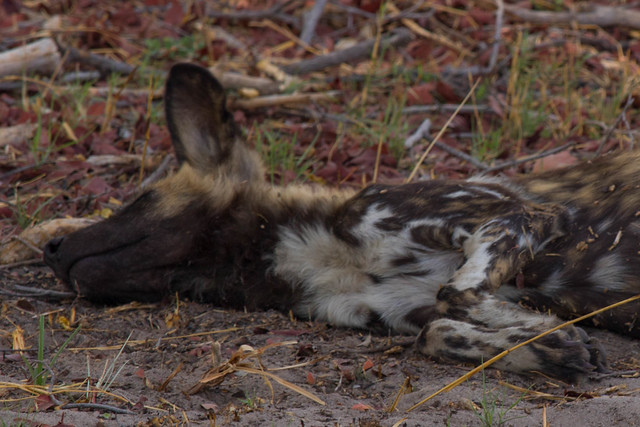
The dogs were mostly lounging, so we moved on after snapping a few pictures. Then magically, we found a pride of lions – a couple of adult females and a few young ones.
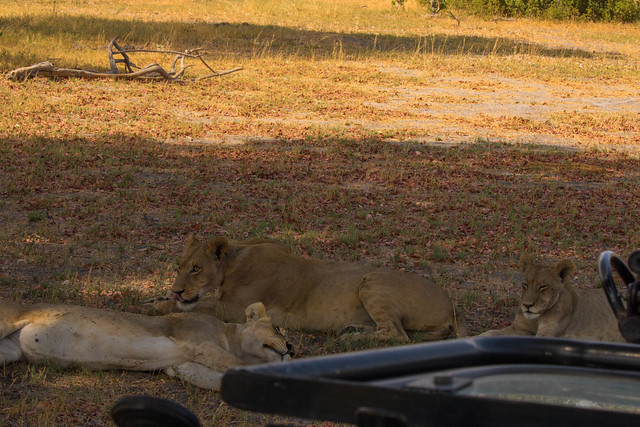
What are these two cubs doing??

Oh, the one is using a warthog head as a chew toy…
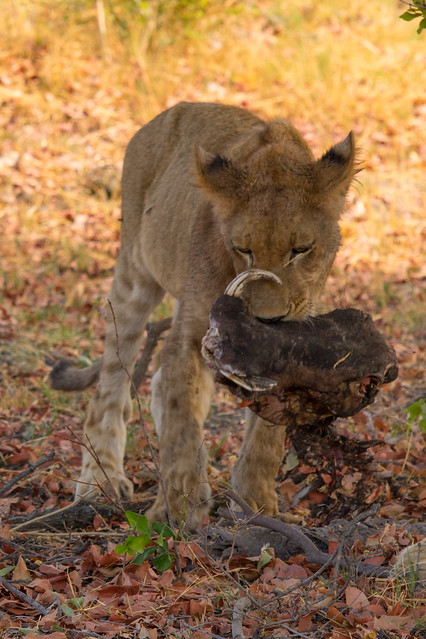
… and the other is using the tree branches as a pillow, of course.
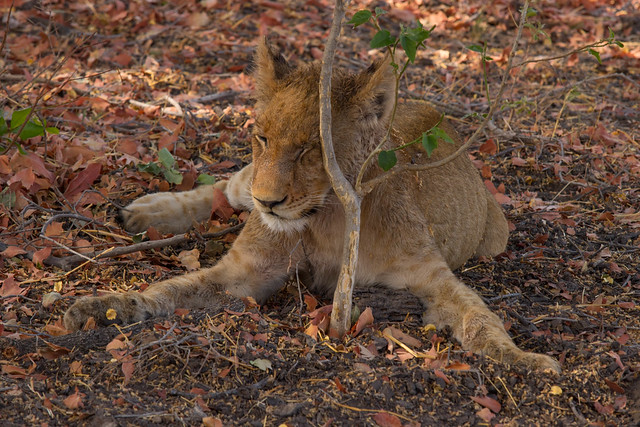
And one of the grown-ups was looking majestic, even with some dried leaves on her face.

Then we moved on and found a spot for our morning coffee.

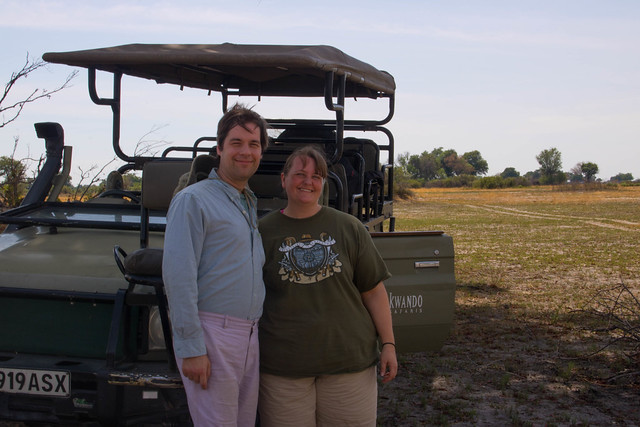
After that, we returned to the camp for lunch and our afternoon siesta time. I was too hot to nap, so I hung out near the lagoon in a loft, watching the elephant graze across the lagoon. I read and journaled. We also shopped a little in the curio store, finding a few things to give as gifts when we got home.

Our evening “drive” was actually to a dock in the Moremi Game Reserve. We were to take a boat ride to an island where thousands of birds are known to nest.

A tiny frog jumped on Andrew. We tried to return him to the water, but he hung on to the boat for a good long way before jumping off himself.
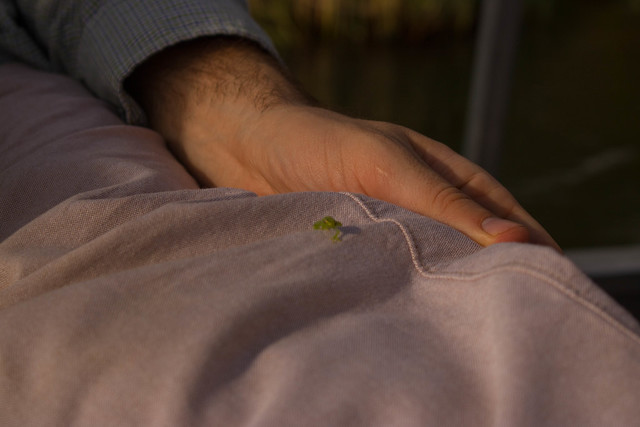
And when we rounded a bend in the river, we spied this guy.
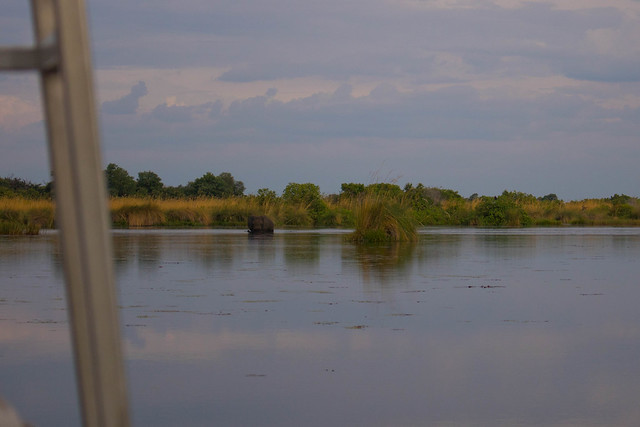
This bachelor elephant didn’t really like us in his corner of the river.
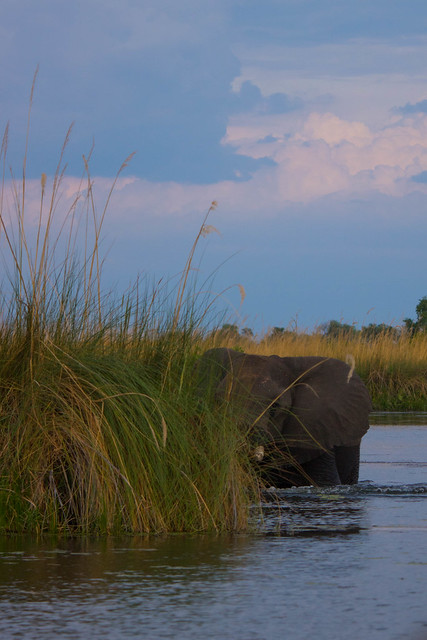
He came over, stared us down, and swished his trunk angrily through the water.
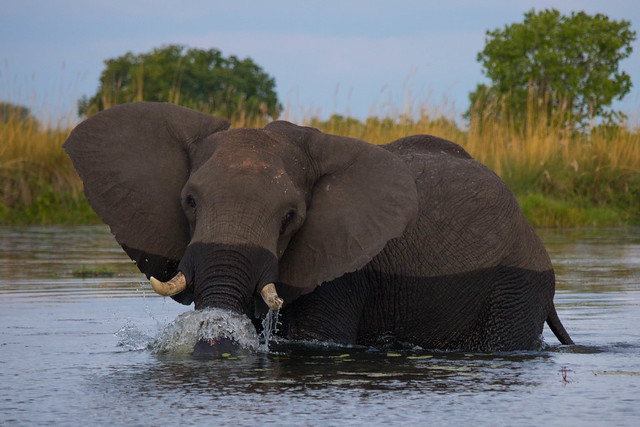
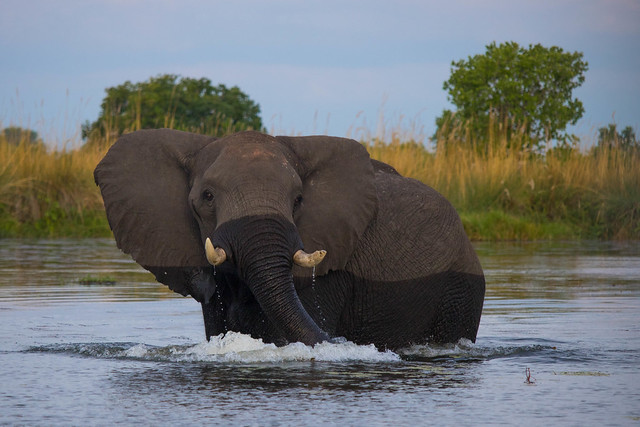
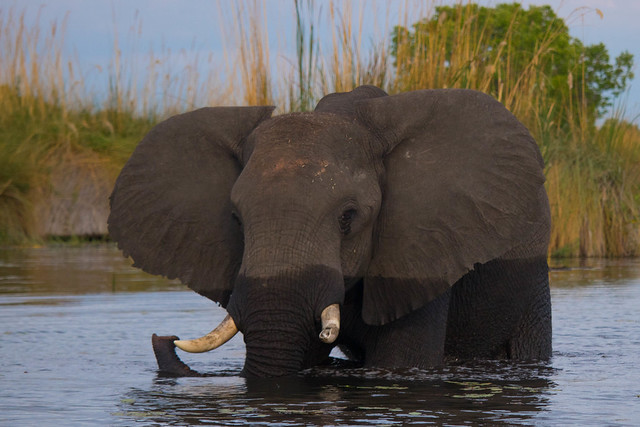
Then he eventually decided we weren’t a threat – or at least not an immediate threat – because he returned to the side of the river where he foraged for a while longer. Though he continued to keep at least one eye on our boats.

Then we moved on to the island with the birds.

When the sun started setting, we had to hurry back to the dock, since the reserve closes at midnight.
After a customary dinner with the rest of the camp and staff, we returned to the tent and to bed.
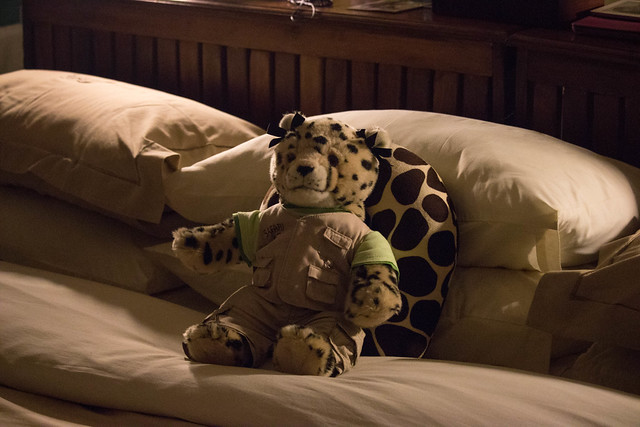
Tags: safari
Posted by barb on Nov 21, 2016 in
Pictures,
Recreation,
Travels Mike, our guide from Chobe Elephant Camp, left us at Kasane Airport, but not before handing us over to one of the airline representatives. We felt a bit like a package, being moved from one place to another, but honestly, we were thankful for it – it meant that we make it where we needed to be.
Today would be our first time on one of the many small aircraft that would shepherd us around to the various camps. I loved the ride – it was a little bouncy, but the view was spectacular. The airstrips near the camps were packed dirt, which was a little disconcerting, but worked just fine. Here’s our plane taking off after it left us at Kwara Camp.
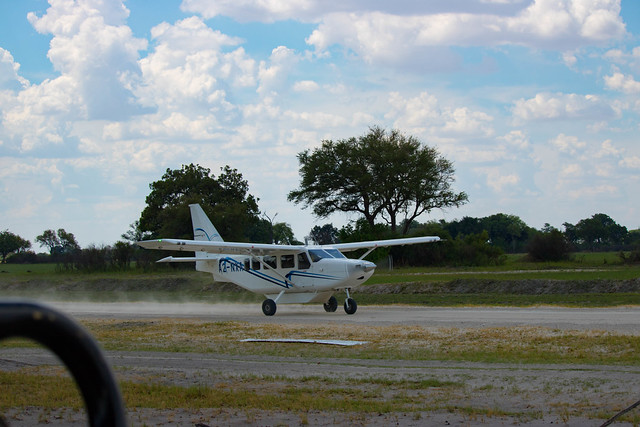
During our customary safety briefing in the camp’s lodge, this elephant was grazing across the lagoon – greeting us to the camp.
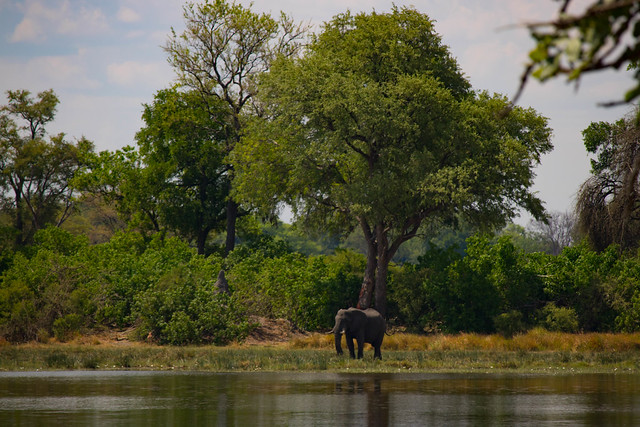
We were then shown to our tent. This was our first bona-fide tent on our journey. We quickly found out one of the down-sides: the baboons were running around the trees, bouncing off our tent roof to their next destination!
But, the tent itself was beautiful. We overlooked the plains, where we could often spy elephants or antelope. There was no mosquito net, which made us glad we had brought our own – we were able to hang it from the ceiling. We wondered if we were being over-cautious, but later in the night, we watched fireflies circling.

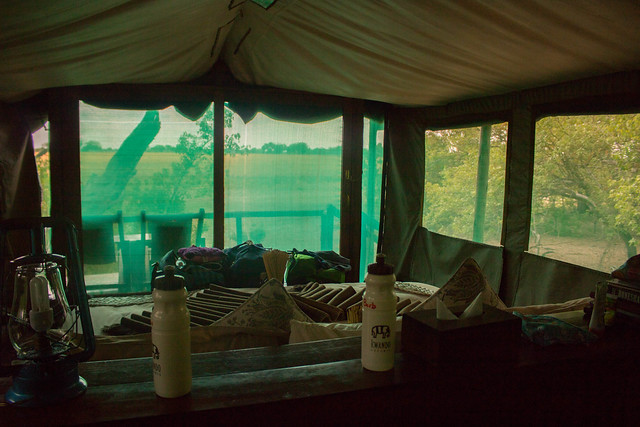
After unpacking and a short rest, we returned to the lodge, with this view. The fire pit is where we’ll have breakfast each morning, and can sit after dinner at night (though if Chobe is anything to go by, we’ll be too tired to sit around much after dinner).
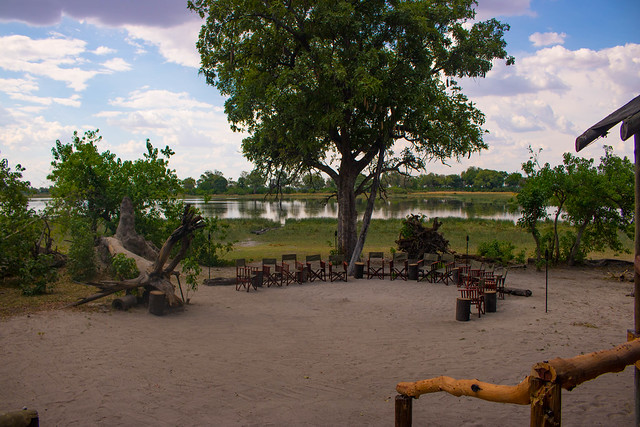
Before long, we started off on our afternoon drive. Our guide, Carlos, and our tracker had heard a pair of leopards mating earlier in the day. They were hot on the trail, but weren’t able to find the leopards before they needed to be at the airstrip to meet the plane. However, that meant that Carlos knew the general direction of the leopards, and from our perspective, drove right to them.
Carlos told us about the mating habits of the leopards. They mate 3-4 times per hour, all day, for about a week. This was how they knew the leopards should still be around.
Sure enough, we found them…um…in flagrante. We watched them do it once, then rest, then before long, the female was demanding the male go at it again. She was quite insistent. We watched several times before calling the other truck and guide so they could see as well.
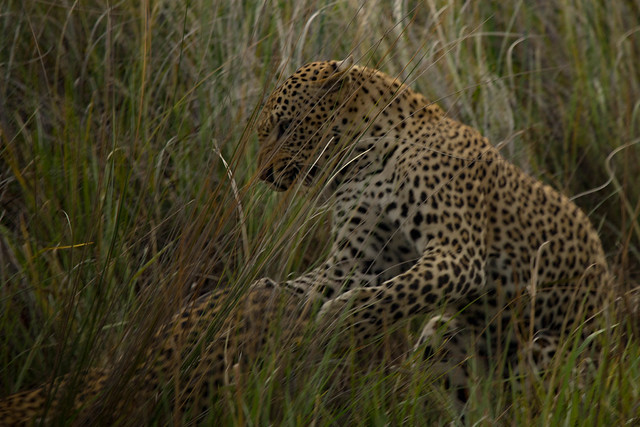
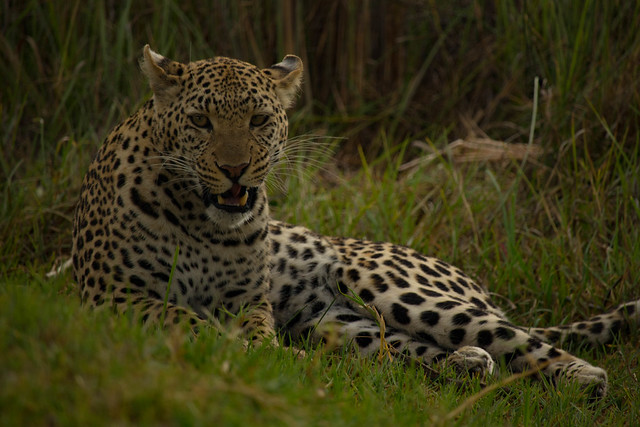
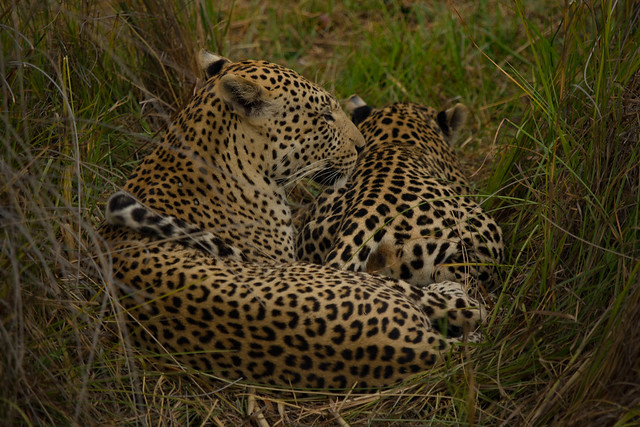
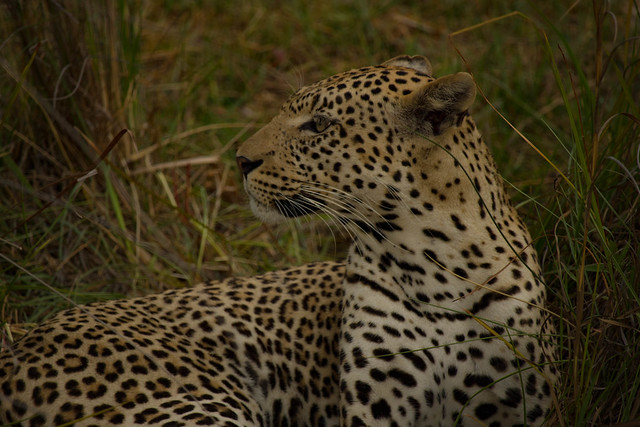
The mating was *very* violent. She would lick her wounds after each session, and it seemed that we could see new ones form almost before our eyes.
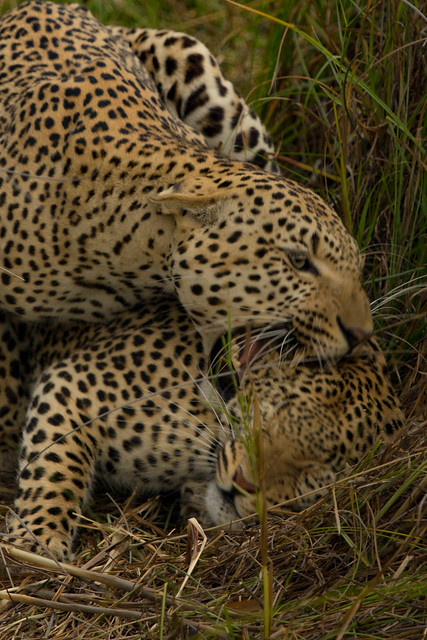
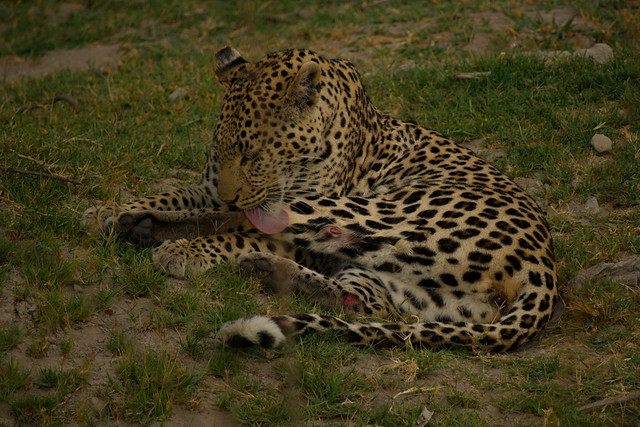
Once the other safari truck arrived, we moved on to see what else we could see. There was some rain threatening, but not for long. When the sky started to clear, we got a beautiful rainbow. And, seemingly at the end of that rainbow, we spied a pair of elephants.
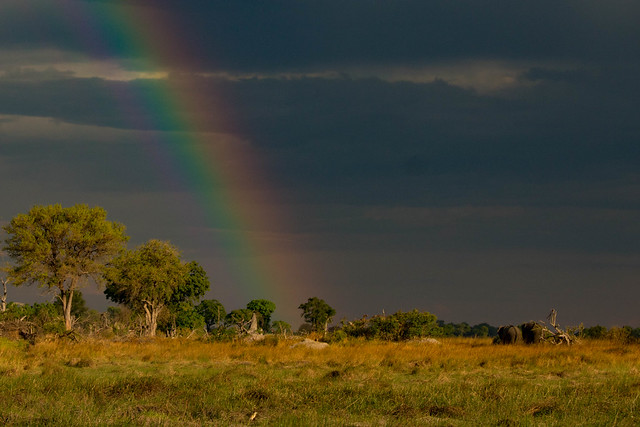

Around another bend we found this zebra – lit by the dusk. He kept a close eye on us.
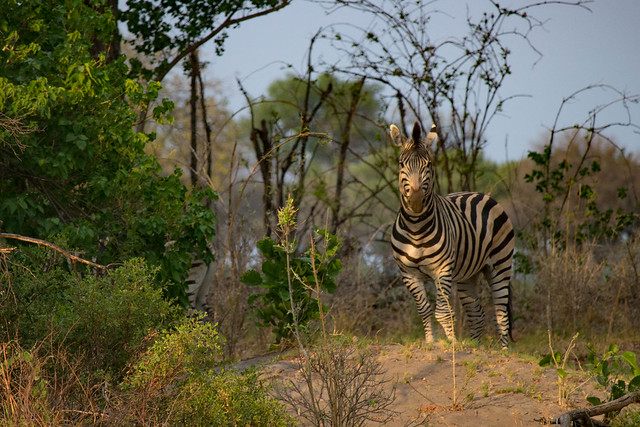
And then Carlos and our tracker found a pack of wild dogs. We saw a group of tsessebe antelope running, so the guides headed toward where the antelope were running away from.
Then we spied the dogs jumping – they do this to get a view over the grass at their potential prey.
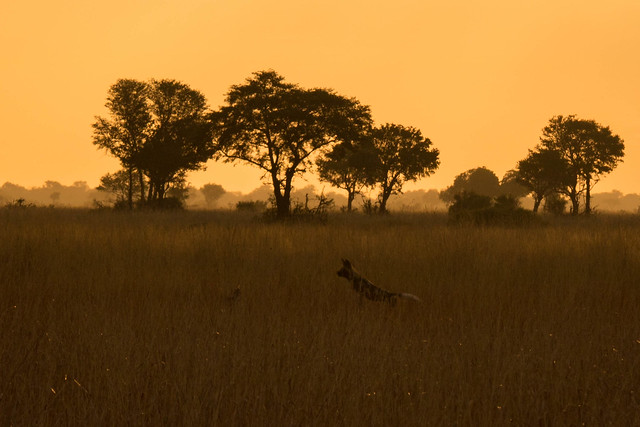
Thankfully, we did not witness the kill, but our guides found them munching on a fresh body. They are vicious and had made short work of the kill.
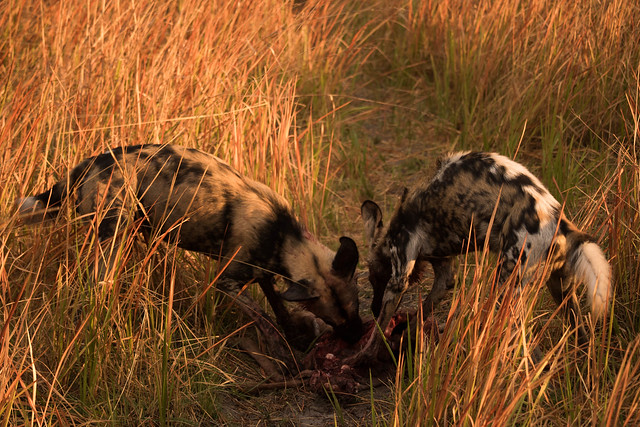
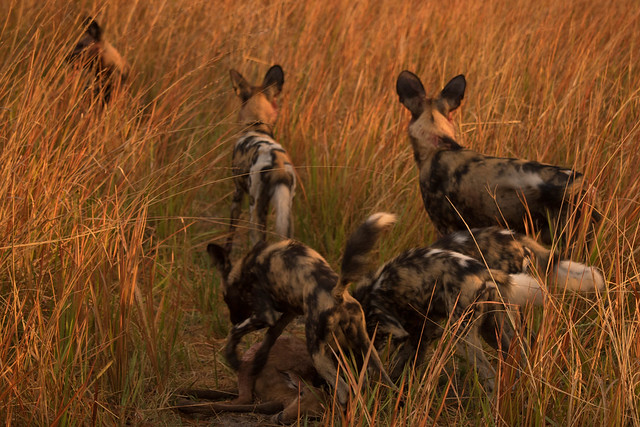
When we arrived back at camp, we unwound with our safari group with a drink before dinner.
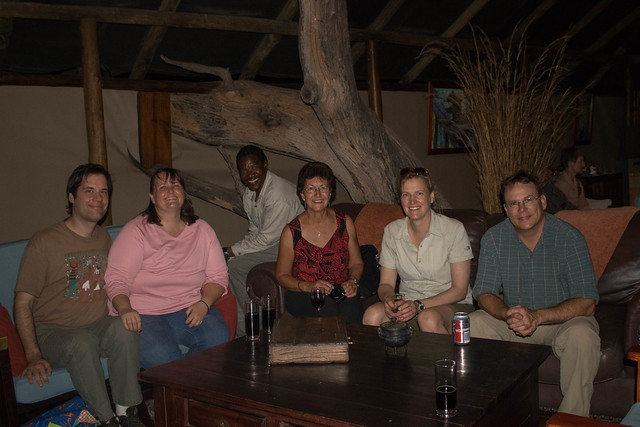
Tags: safari
Posted by barb on Nov 21, 2016 in
Pictures,
Recreation,
Travels We had time for one more morning drive though Chobe before we had to catch our plane to our next camp. So, we set out after a quick breakfast.
The day started out much more promising than our nearly fruitless quest yesterday for elephants – when first thing we found a family.
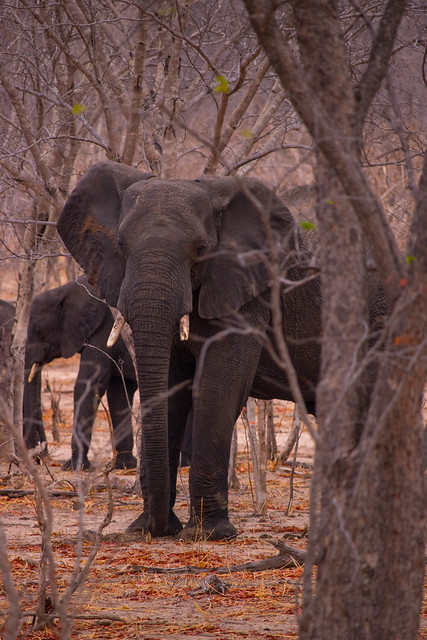
And further into the park, we found a herd of kudu.
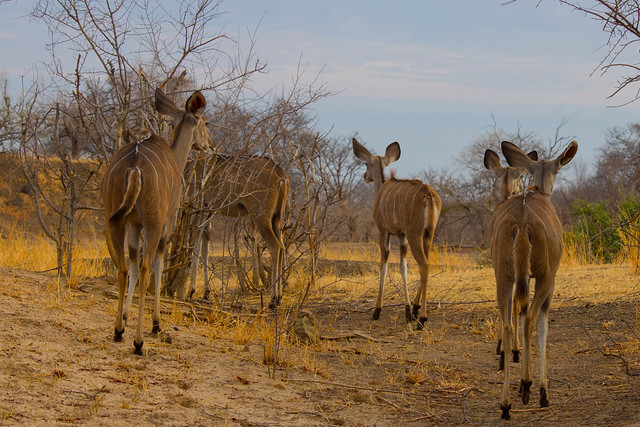
And a trio of giraffees
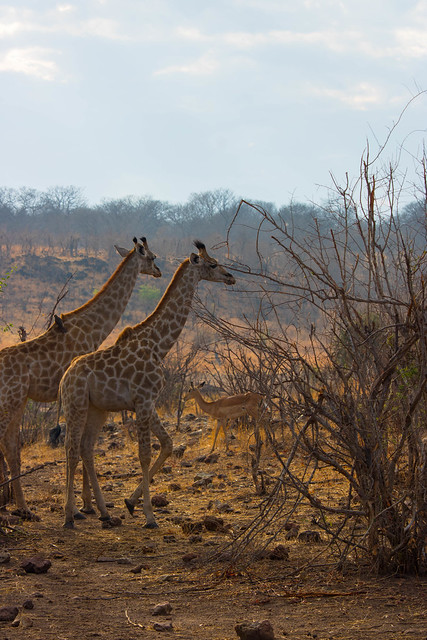
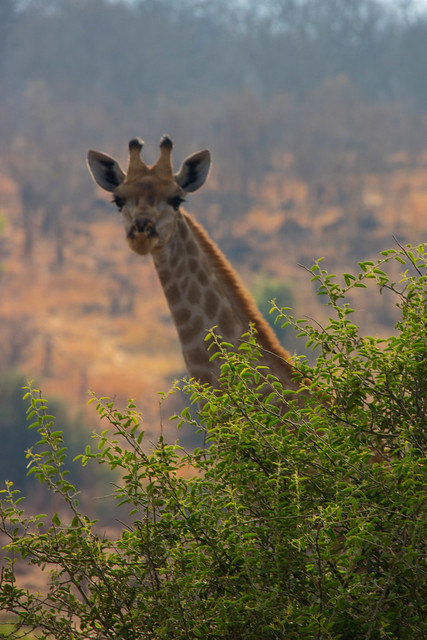
The trend of more and more impala babies continued, too.
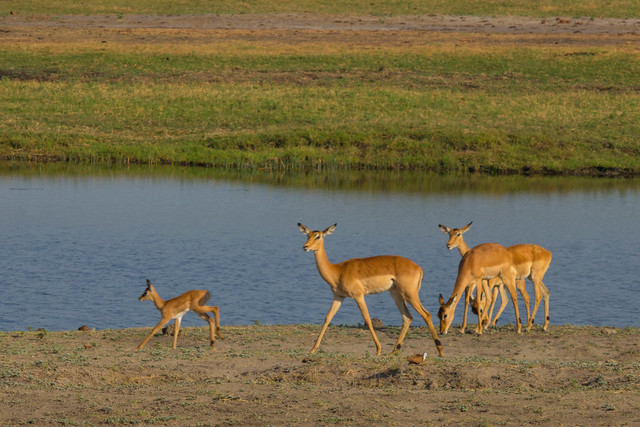
We saw something new – some banded mongoose:
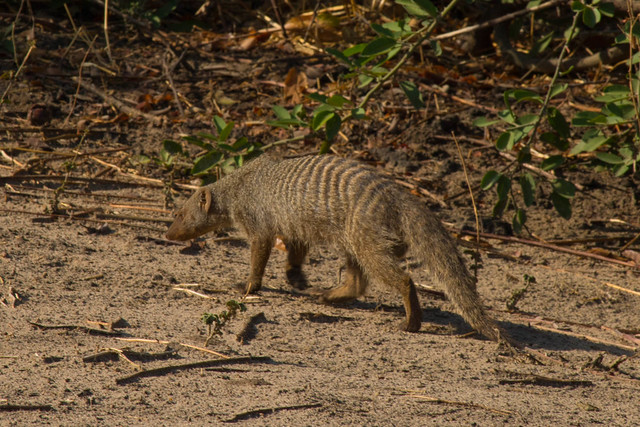
Down another road, we found this guy just hanging out – resting his neck in the crook of a tree.
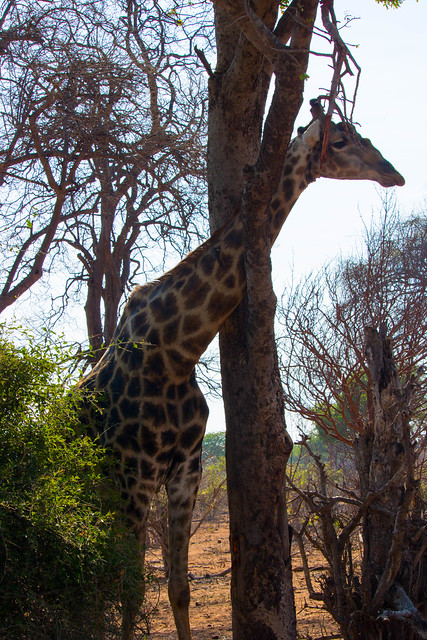
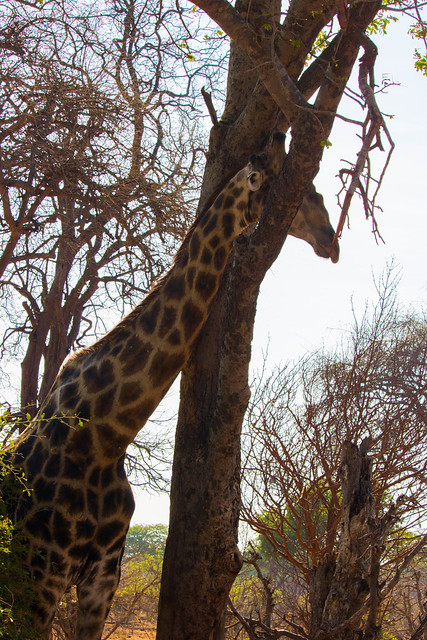
Mike, our guide, was a little concerned that he might be stuck, but when we got a little closer, he dislodged and moved on. Sorry guy! Didn’t mean to disturb your rest.
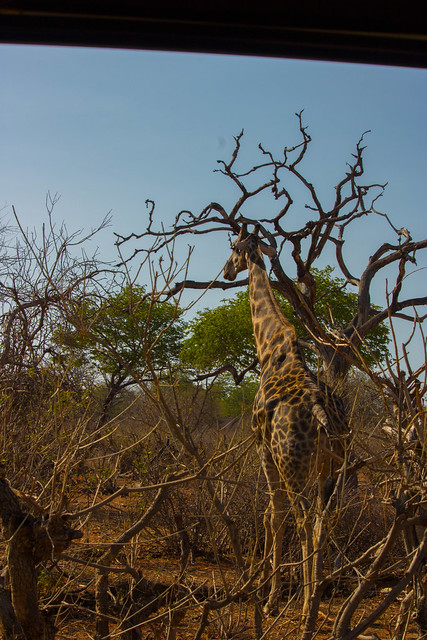
And then…and THEN…we turned another corner, and our guide spied this:
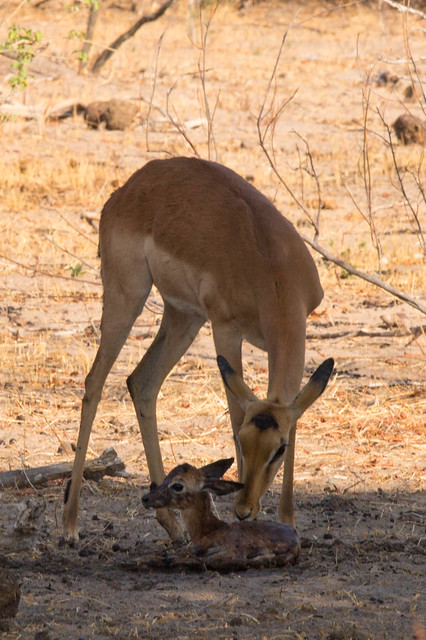
A newborn impala. And by “newborn”, I mean a few minutes old. We parked, waited, and watched – hoping to catch this baby’s first steps.
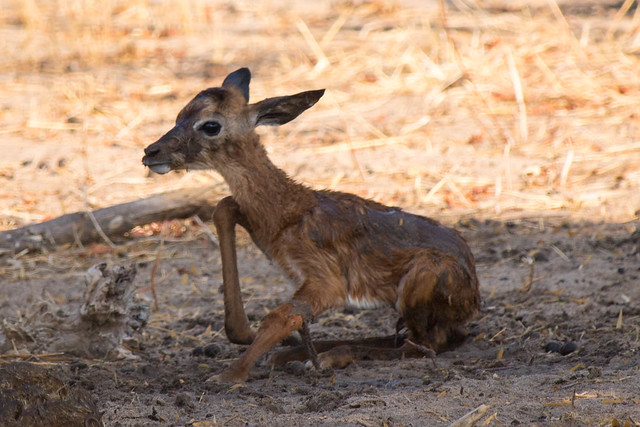
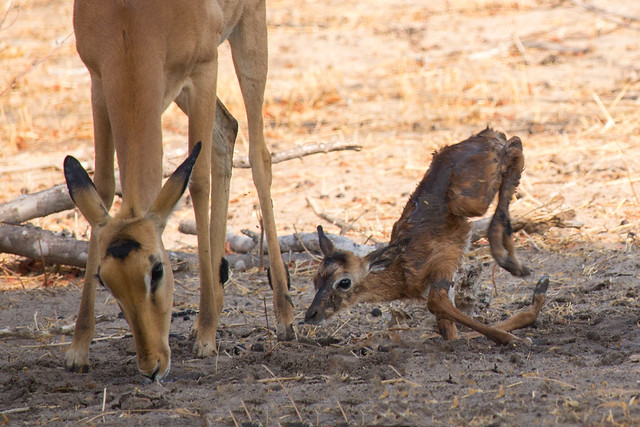
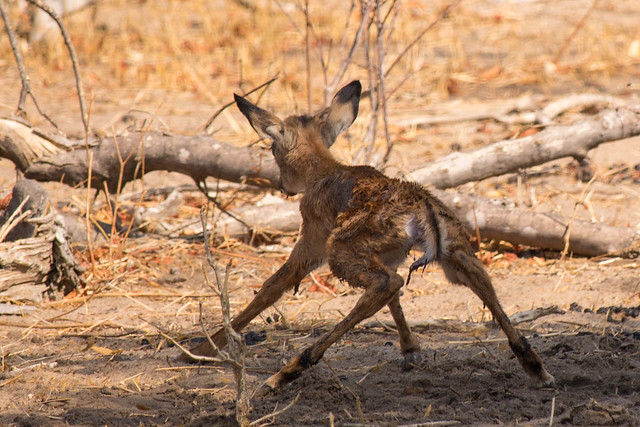
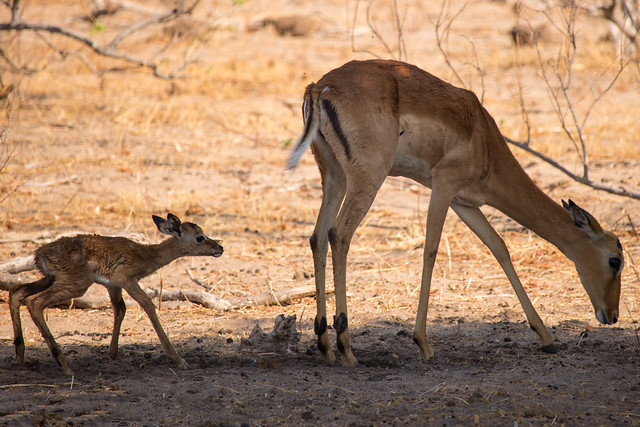
Until finally it made steps toward mama.
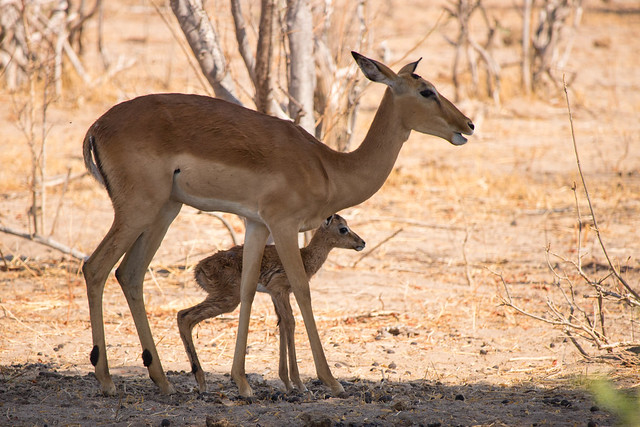
It tried to nurse, but mama seemed to be a bit new at the whole thing, too. She stepped away the first few times, cleaning baby. Eventually baby got in a few drinks, and we headed off.
We took the long way out of the park, on one last quest for elephants, which paid off big.
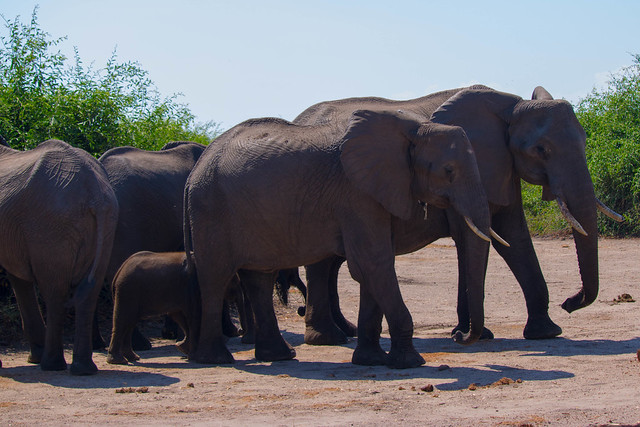
Including this little one:
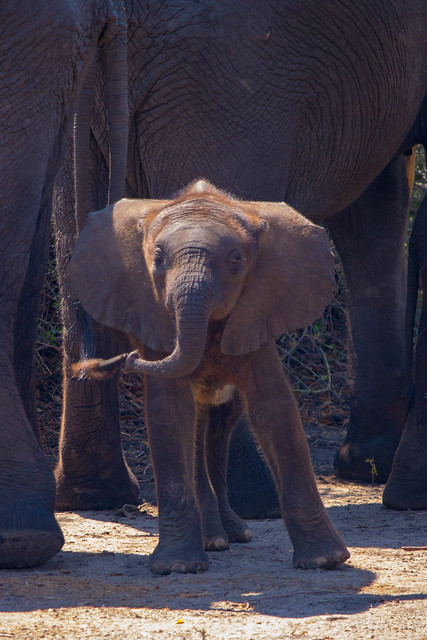
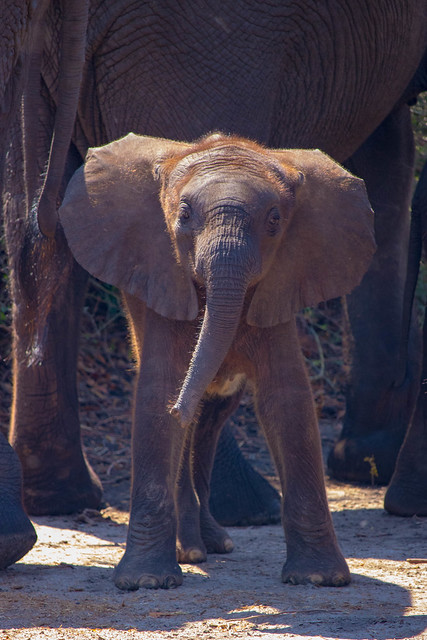
And we looked over the river and saw this:
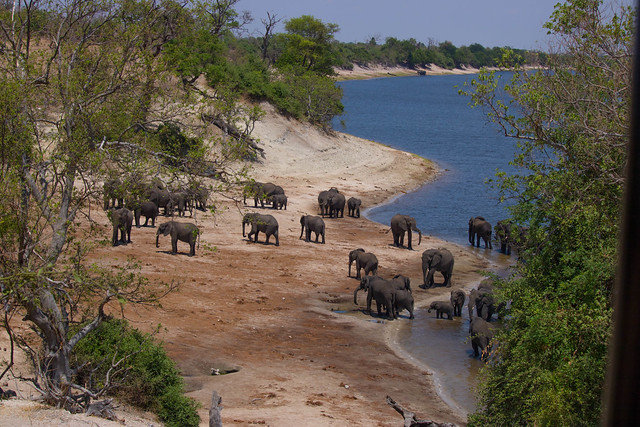
So many elephants!
Finally, we had to get to the airport to catch our flight to our next camp. But on the way, we spied one last treat – a pile of sleeping wild dogs.
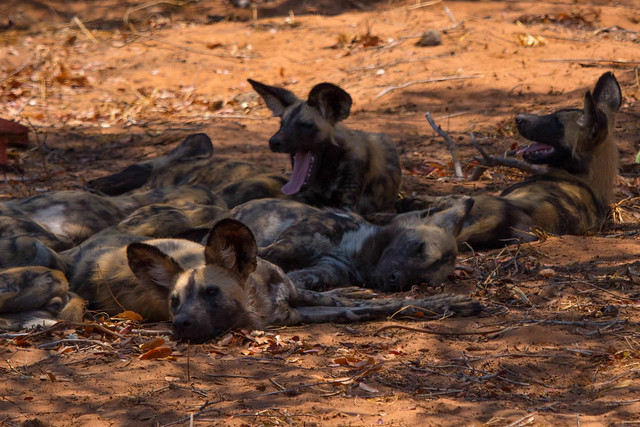
And then Mike dropped us at the Kasane airport – leaving us with one of the agents who walked us through catching our flight.
Tags: safari
Posted by barb on Nov 20, 2016 in
Pictures,
Recreation,
Travels Our third day at Chobe – another full day there – was spent in pursuit of elephants. Mike, our guide, warned that it might be a bit of a goose chase because of the clouds and possibility of rain. Elephants need water every day. During the dry season, they trek to the river each day to drink and bathe. However, they prefer their watering holes, since they are less vulnerable there. Once the rains start, the elephants know that their watering holes will soon have water again. At the end of the dry season, when the weather is cloudy and there are sprinkles in the morning, the elephants walk to their watering holes to see if there is water yet. If there isn’t any water, they have to make the trek to the river – 10 km away.
On our quest for elephants, though, we did find other animals. First thing, we found some zebra.
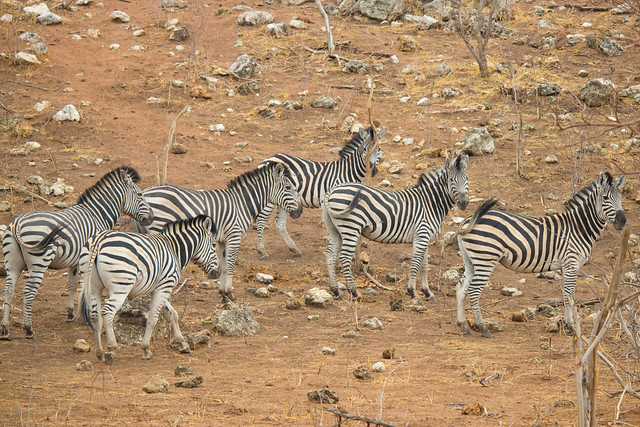
Including this little one. Our guide guessed that it was less than a month old. Note how long its legs are. Mike said that the baby zebras have long legs to help confuse predators. It’s harder for them to tell the young from the older zebras from just a quick glance.
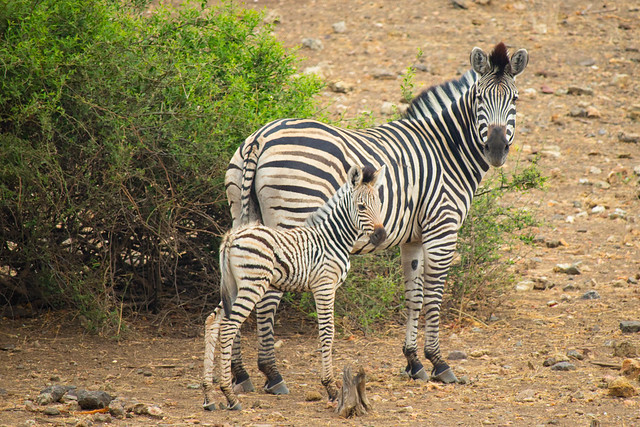
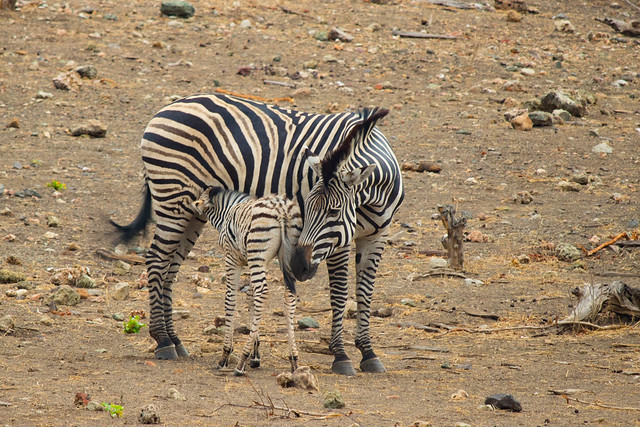
We continued to see more baby impalas, too.
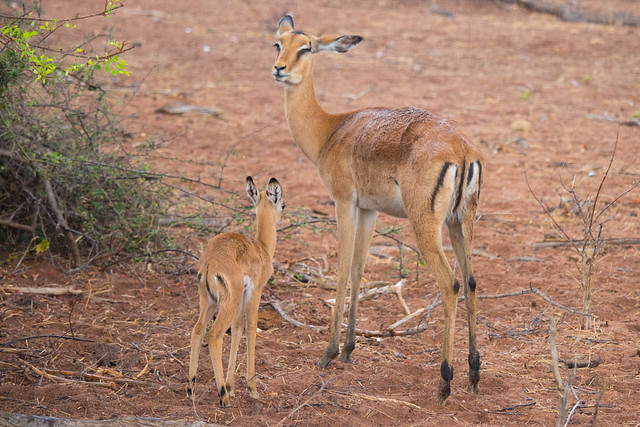
Next, Mike took us to where he knew a pair of lionesses had cubs. His hope was to get there about the time they would call the cubs out of hiding to exercise them. We drove around the area a bit, Mike looking into the bushes where he guessed that the cubs might be hiding. He spotted a couple tiny cubs through the bushes. Eventually I spied one of the cubs, too – it was barely able to walk, crawling over a branch of a bush. Then it disappeared again. I have no idea how Mike knew they were there or how he could possibly have found them.
Then we found the lionesses.
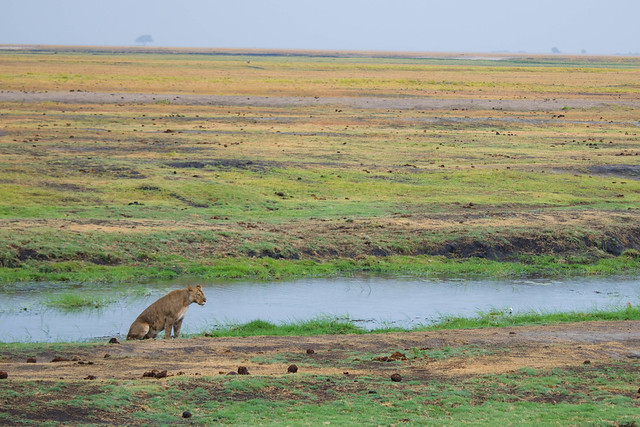
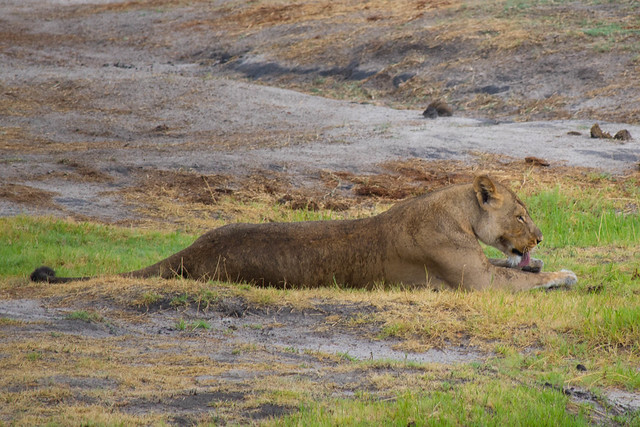
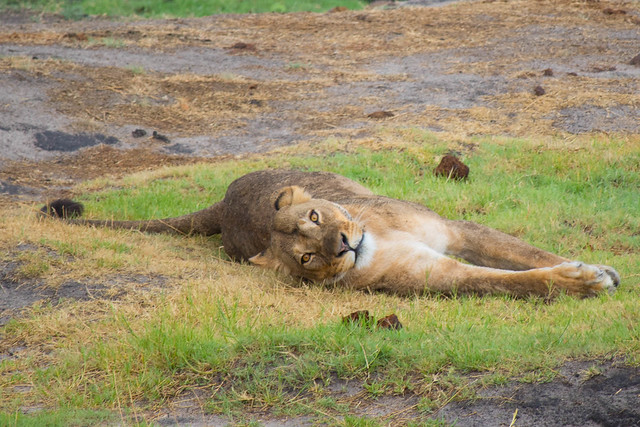
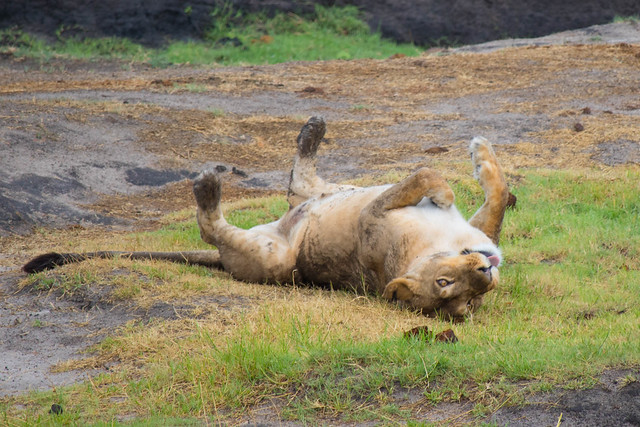
After watching for a while, Mike determined they weren’t going to call the cubs out, probably because it looked like rain. So, we continued our trek to find elephants. We drove to one watering hole, then then to a more distant watering hole. But…this is what we found:
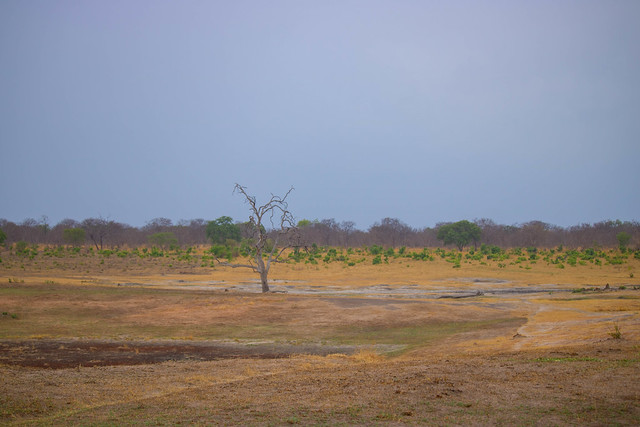
Mike was so frustrated. At one point he just looked around and said, “Where are they?” And then we continued to another watering hole. Still no elephants. So, next we headed toward the the river again. And FINALLY we spied a family.
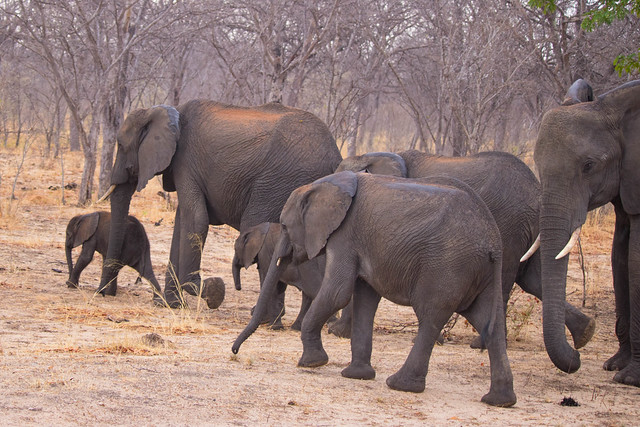
We followed them to the river, where they got some water.
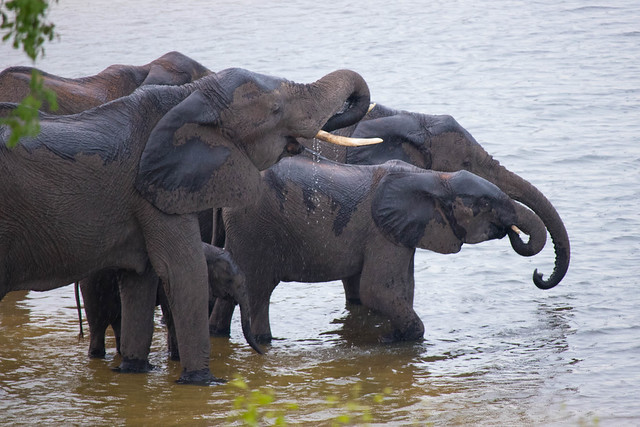
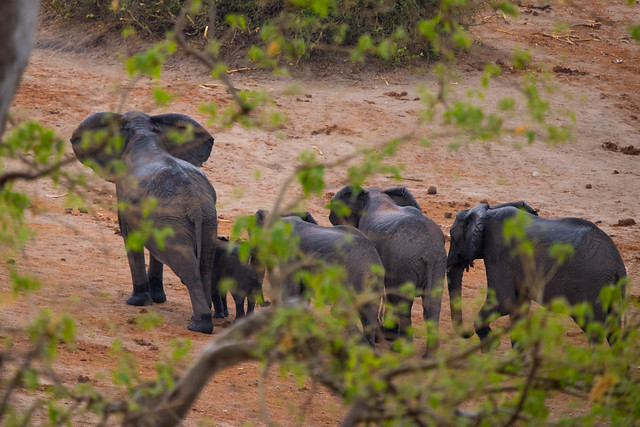
And just like that, they headed off again.
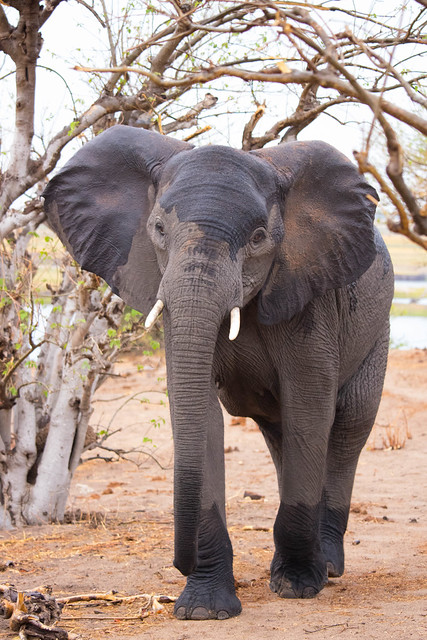
We returned to where the lionesses were – Mike thought they might call out the cubs in the late afternoon. On the way, we spied some jackals and a warthog with babies.

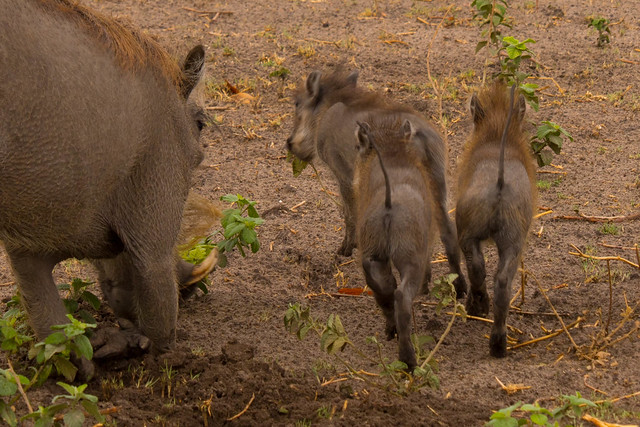
Then we found the lionesses in about the same place as in the morning.
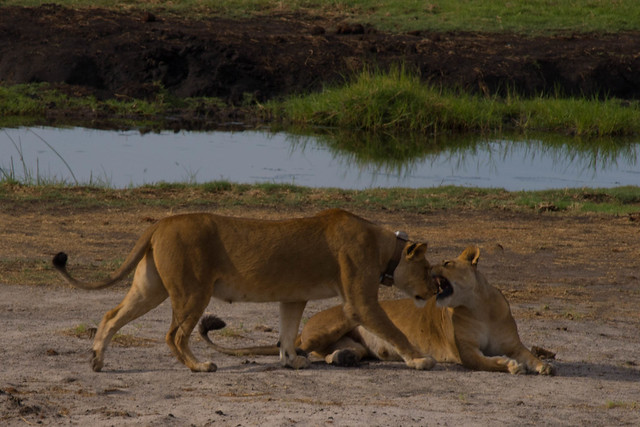
The then, before long, one of them went and called her cubs.
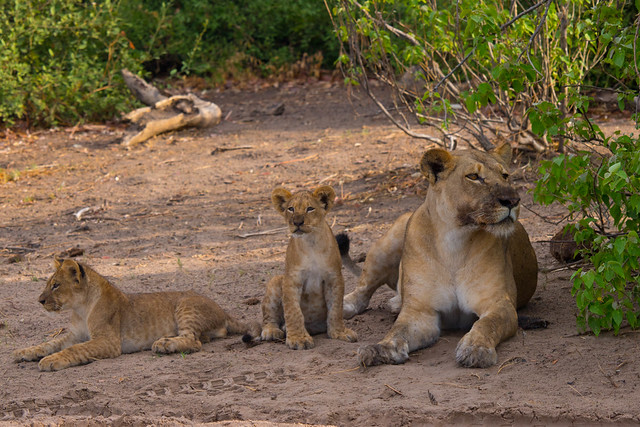
They ran around, explored, and played with each other for a while.
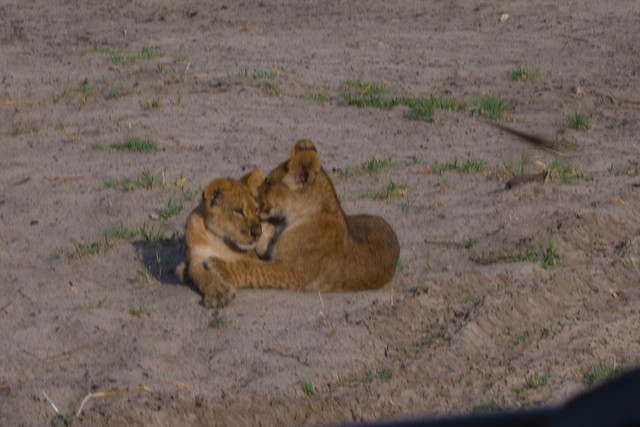
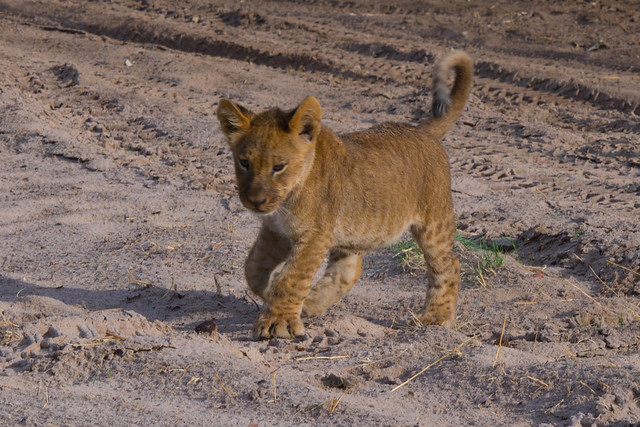
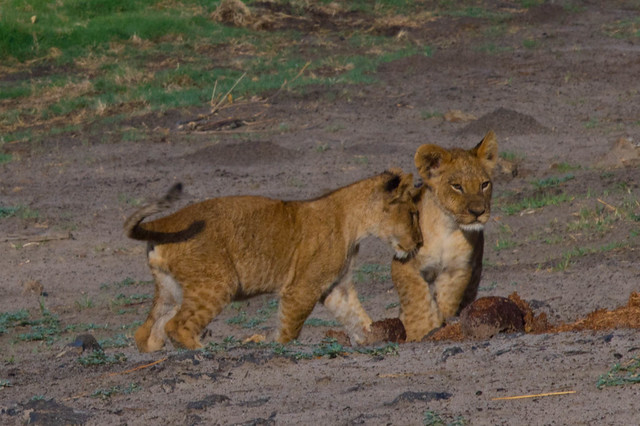
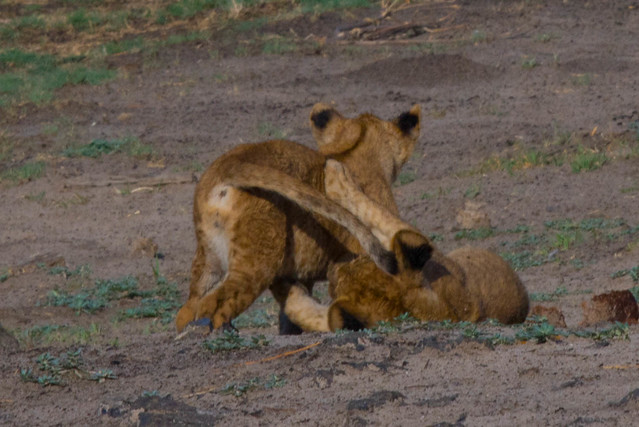
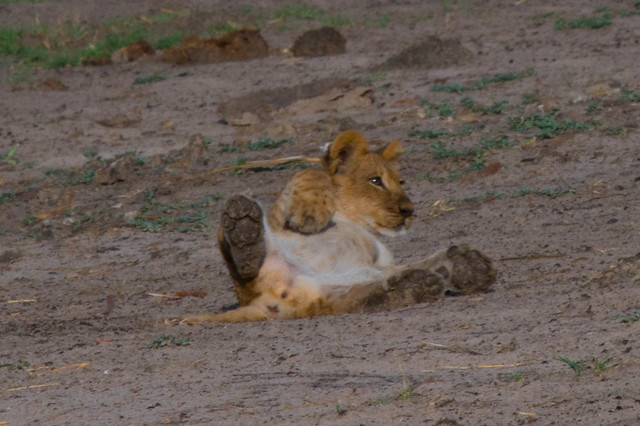
And then they went back to mama.
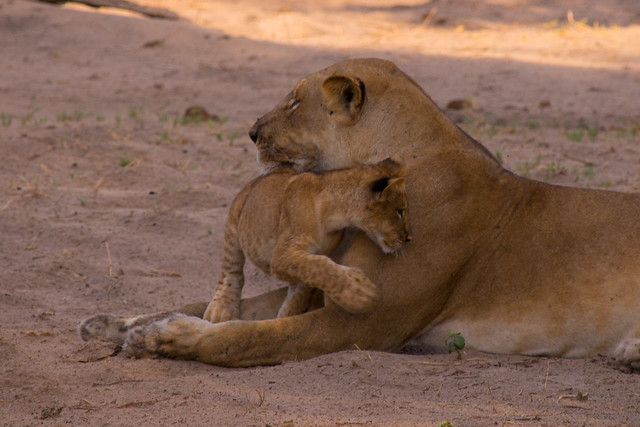
And nursed for a little while.

Finally it was time to head back to camp. On our way, we spied this mama and baby giraffe at sunset.
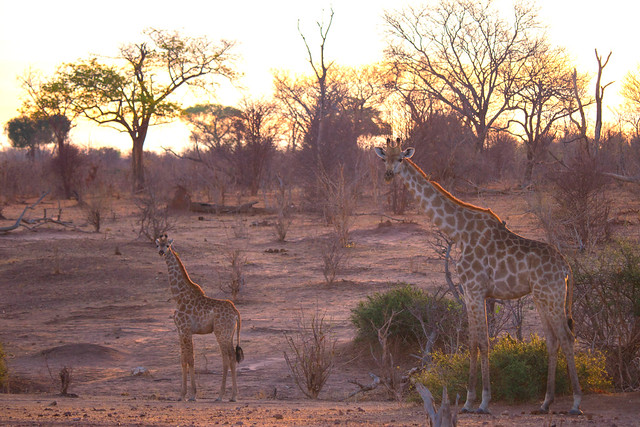
Tags: safari
Posted by barb on Nov 19, 2016 in
Pictures,
Recreation,
Travels Our second day started early, with a wake-up call around 5AM, light breakfast in the lodge, and then off in the safari truck. After Mike signed us into the park, we didn’t have to go far to find some wildlife.
We spied a hyena patrolling the road. They know that animals get killed by vehicles, so they check out the roads first thing in the morning.
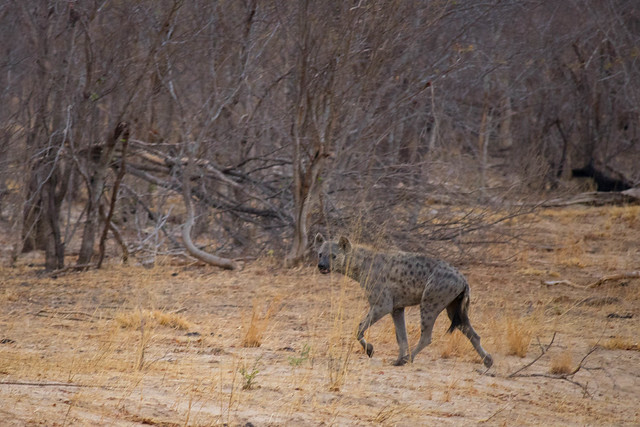
Oh, but then this happened.
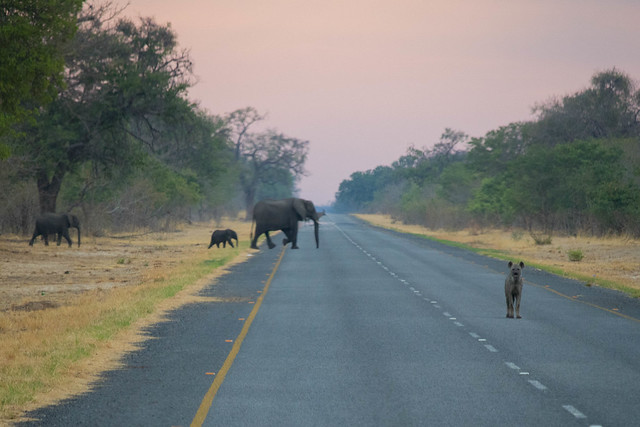
And we had to wait for some formidable traffic.
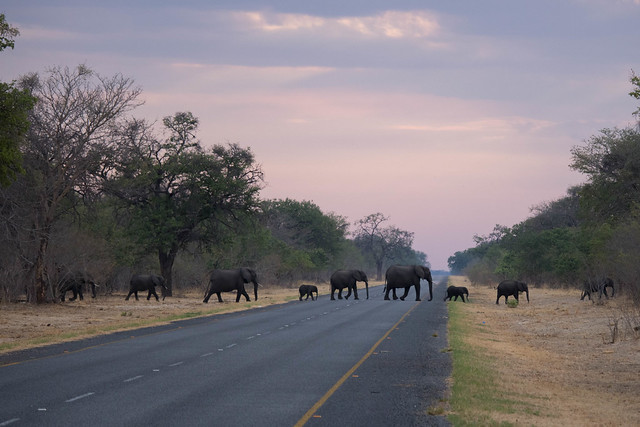
Rule number one of finding wildlife is to go to the last place you saw something, so we started our morning checking out the site where the lions were eating the buffalo the previous evening. No lions, but another buffalo carcass and some scavengers.
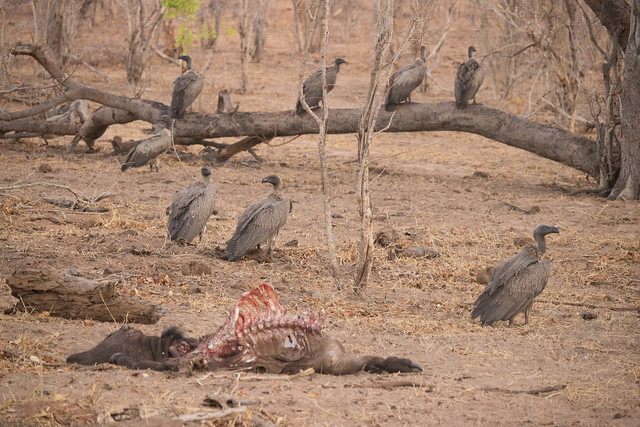
I can’t really enumerate everywhere we drove and everything we saw after that, but we did go back toward the river, then drove various roads through the park.
We found zebras…

…giraffes…
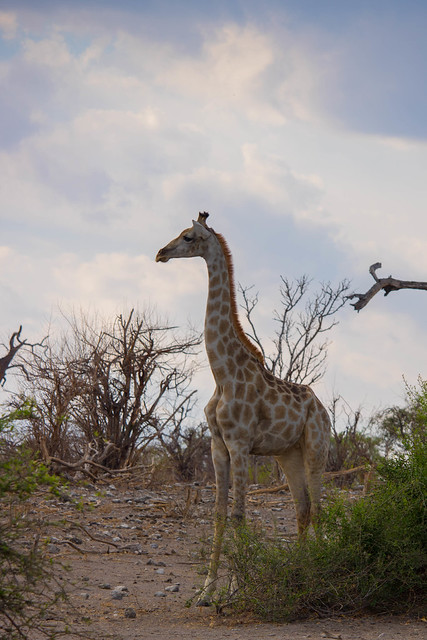
…and water buffalo.
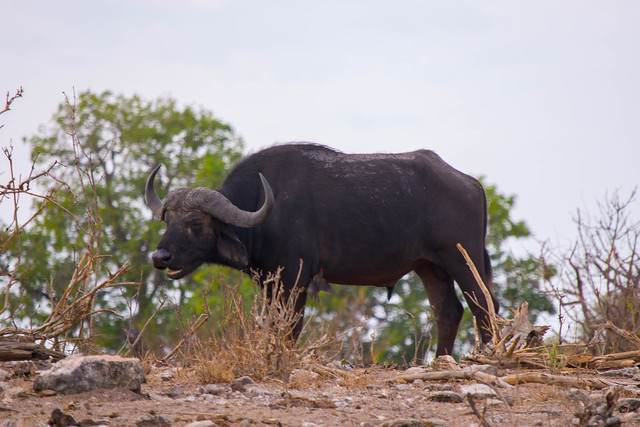
Andrew even spied a leopard tortoise, and had Mike stop so we could grab some pictures.
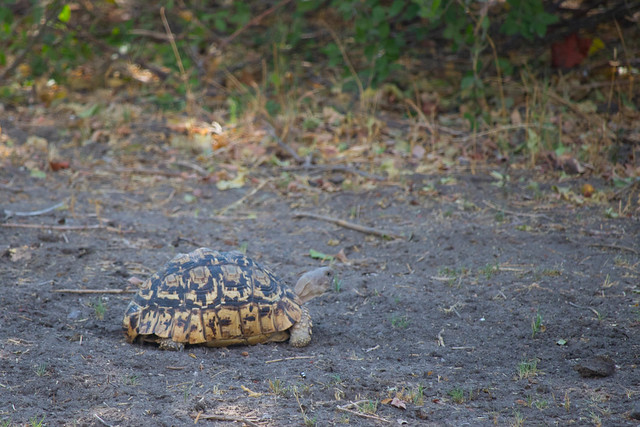
We also spied a few baby impalas. Apparently they all give birth around the same time, just after the first rains. (Or, at least, they have some bit of control over when they drop their babies, but if the rains come too late, they start coming anyway.)

We also found this lion.

She was coming from a kill near the river, but over a rise where we couldn’t see. There was a small group of lions, resting after they had eaten. We saw some vultures moving in toward the carcass, and one of the lions went back out to chase them away. However, the second time the vultures moved in, there was also a tourist boat near the shore, which scared the lions away. We suspect the carcass succumbed to the scavengers after that.
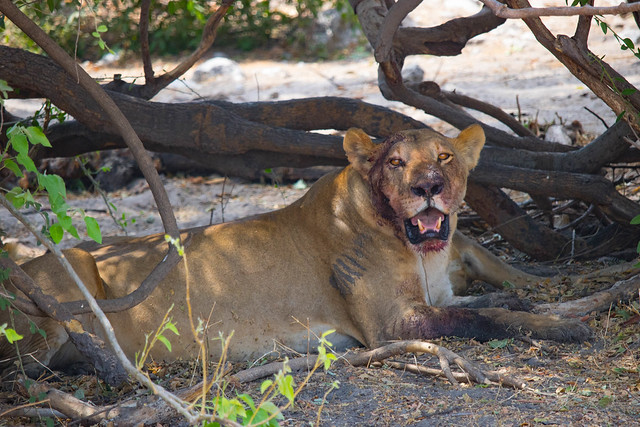
At the same time, there was a herd of antelope keeping a close eye on the lions. They stayed out on the plains, Mike explained, because the impalas best defense against the lions is their speed. In amongst the trees and brush, the lions had the advantage.

After we drove off from the lions, we started to find elephants.
Near the river they were drinking and bathing.
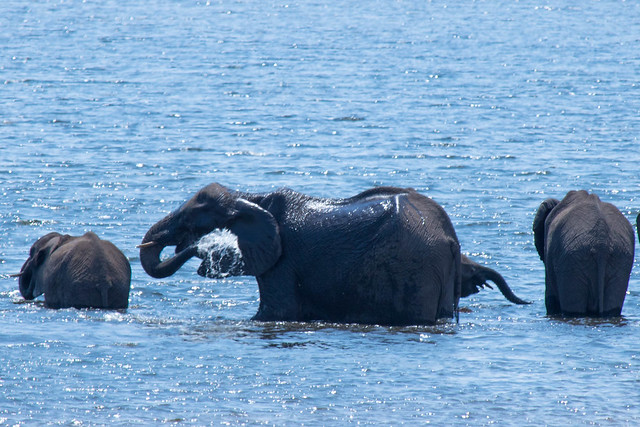
And then taking dirt baths.
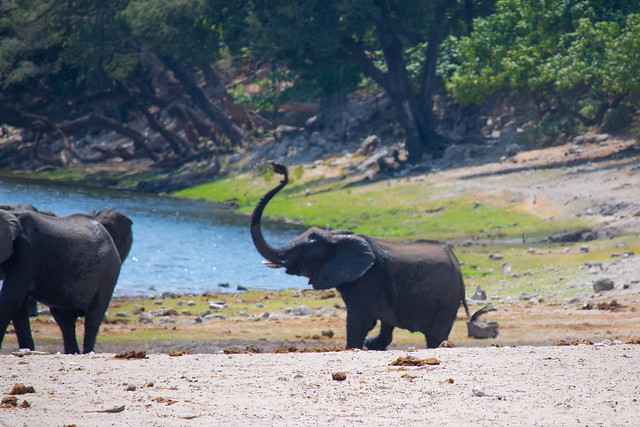
Back up on the bank, we found a baby.
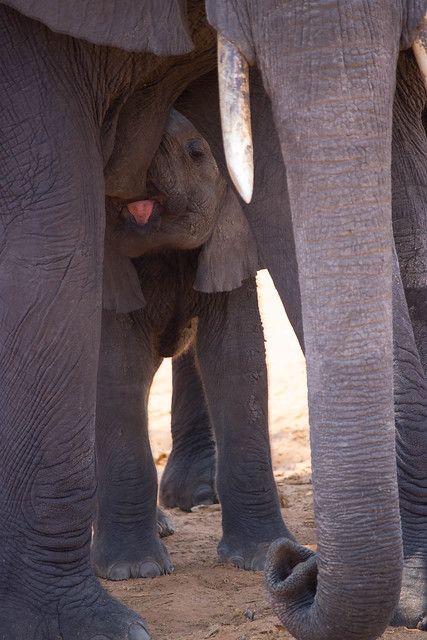
We needed to get to town for a boat ride, but as we were heading that direction, we found another group of elephants. This one just off the road.

They turned toward the road, and one came very close to the truck.
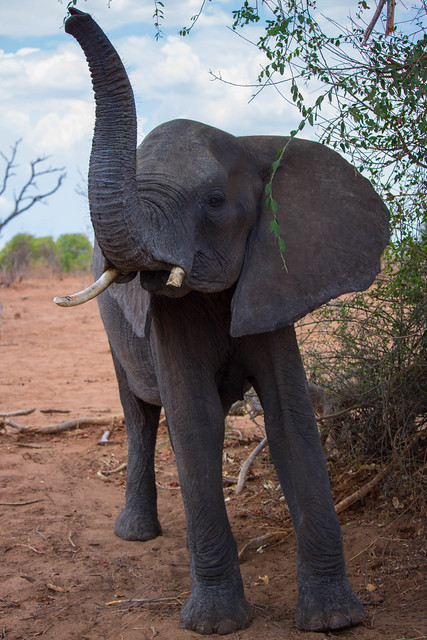
She took a few quick steps toward the truck – it was heart stopping (and I saw Mike grab toward the keys in the ignition, ready to get us out if necessary). When she stopped, she was no more than 15 feet away, and she and I looked into each other’s eyes…or that’s what it felt like. I took exactly one picture, then put the camera down to take in the moment.
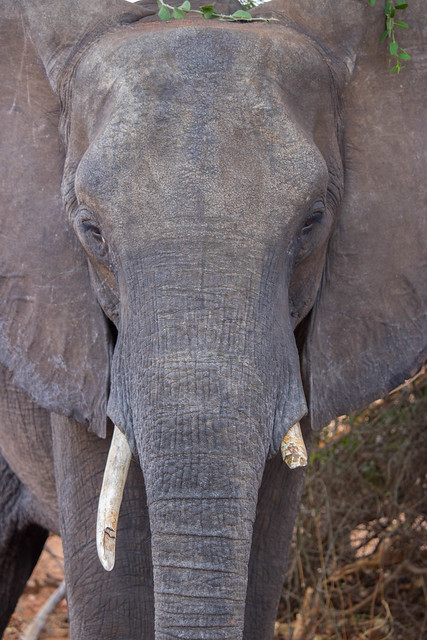
From there, we made our way through Kasane and to the boat for our cruise along the Chobe River.
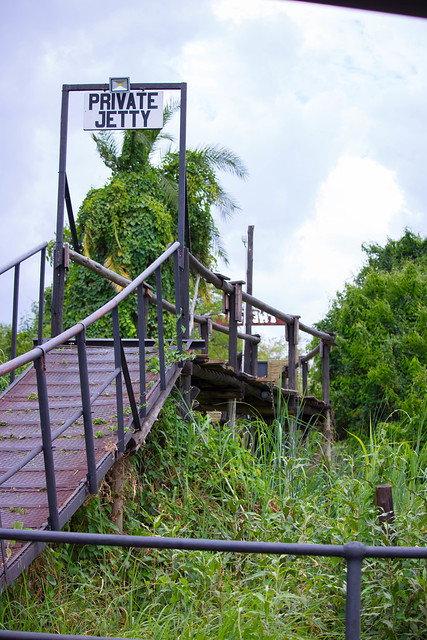
On the boat, we found a water buffalo – very close-up.
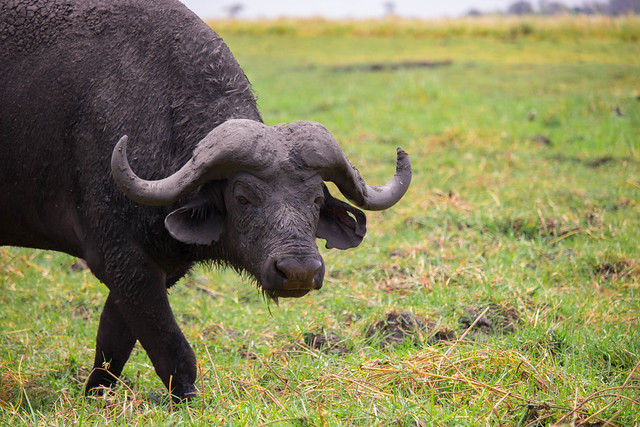
We also passed an elephant carcass (stinky!) with some small crocodiles trying their best to get at the meat. One curious thing, though, was that the carcass was missing it’s face.
Down the river from the carcass, we spied a group of crocodiles going after something. We guessed a buffalo carcass first…
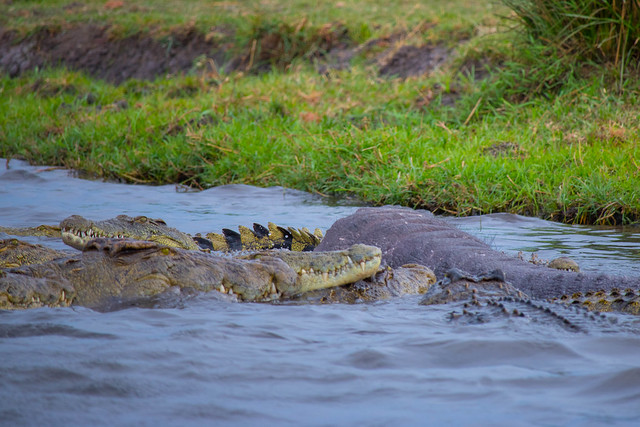
… but as we got closer, we realized it was the elephant’s trunk. Our guide later wondered if the wildlife enforcement had taken the tusks to keep them from being a trophy for someone. Thus, freeing the trunk for the crocodiles.

We watched them eat for a while – it was fascinating. Eventually, one of the crocs tried taking off with the trunk. The others were hot on his tail, though. We continued on down the river.

The boat ride was the first time we got to see hippos out of the water. And we saw a lot of them!

After our boat ride, we made another quick pass through Chobe park, and spied a herd (or tower?) of giraffes.


Then it was back to the lodge for dinner and bed.
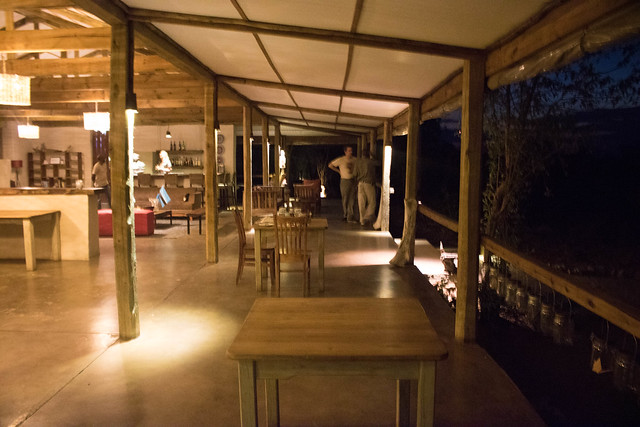
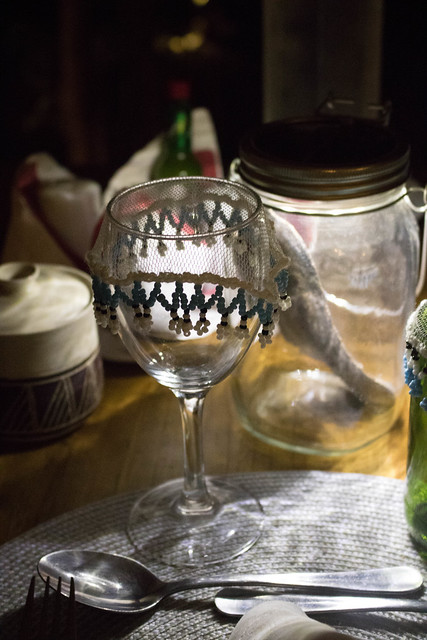
Tags: safari
Posted by barb on Nov 18, 2016 in
Pictures,
Recreation,
Travels As was going to become custom, when we arrived at Chobe Elephant Camp, we were greeted with a house drink (non alcoholic) and a safety briefing in the main lodge. While hanging out in the lodge, Andrew and I were looking over the river and plains, wondering whether we were seeing cattle and livestock or what. The camp manager comes over, looks over our shoulders and says, “oh, those are zebras.” Of course. We were looking at a herd of zebras.
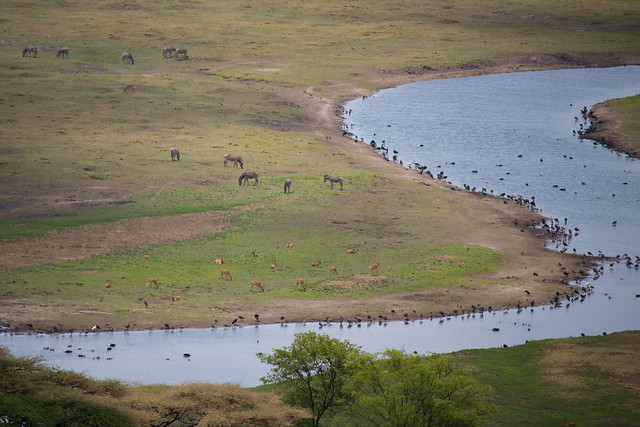
We got settled in our cabin, had tea, and then were taken off for our first game drive. For us, this was the first game drive ever – we were looking forward to what we might see, but trying to temper our expectations. We might see nothing – this is nature, afterall. Nature can be giving and nurturing, or, well, not.
Mike would be our guide for our entire stay. We got in the truck. It was just me, Andrew, and one other guest (who was only staying one night). We stopped briefly, just outside the camp, for a truck safety briefing. Essentially, the animals are used to seeing safari trucks, and the perceive them as a giant, weird, single thing with too many eyes. And they mostly ignore the strange beast. However, if you start to individualize yourself from the truck by standing up, leaning out, or even getting out of the truck, the animals will recognize you as human and a possible threat. Depending on the animal and their mood, it could cause them to run away or to attack. So, don’t do any of those things!
Then we started on our way. But we didn’t get very far before running into a group of elephants, complete with a silly baby! We stayed and watched for a little while before moving along.
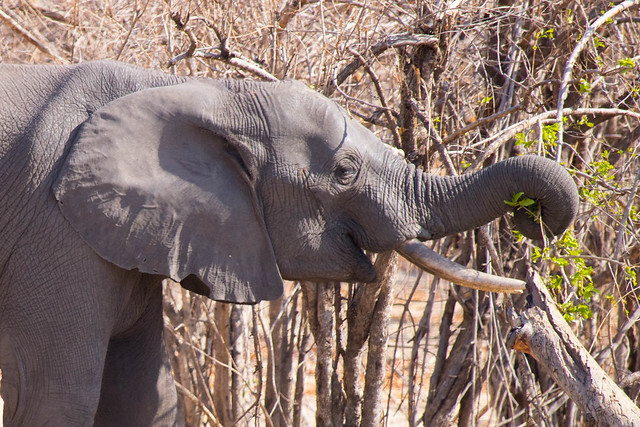
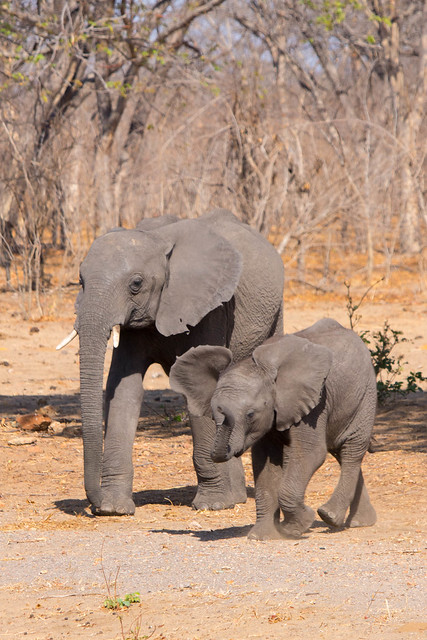
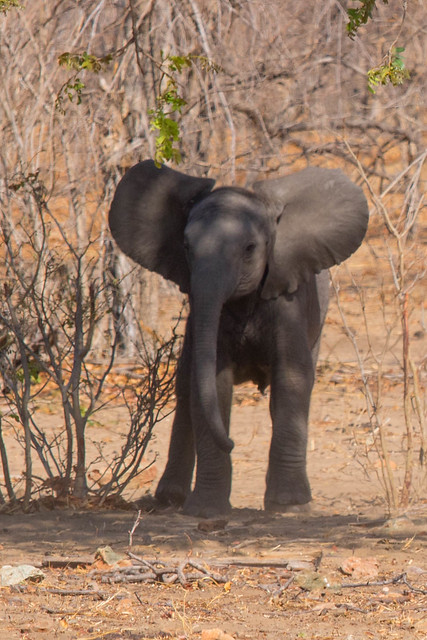
We arrived at the national park, where Mike stopped and signed us in.

And we were on our way into the park!
We were soon introduced to the..ahem…well-manicured roads and an “African massage” – or the wonderful side-to-side rocking from those beautiful roads.

We made our way to the river, where we were treated to herds of impala and zebras. Andrew and I took loads of pictures – it was our first “close-up” for most of these animals in the wild.

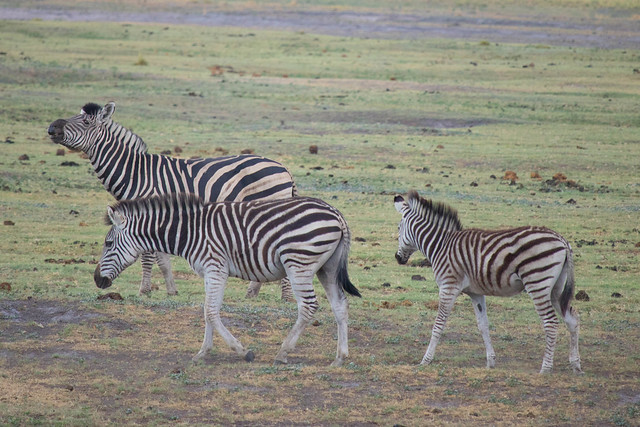
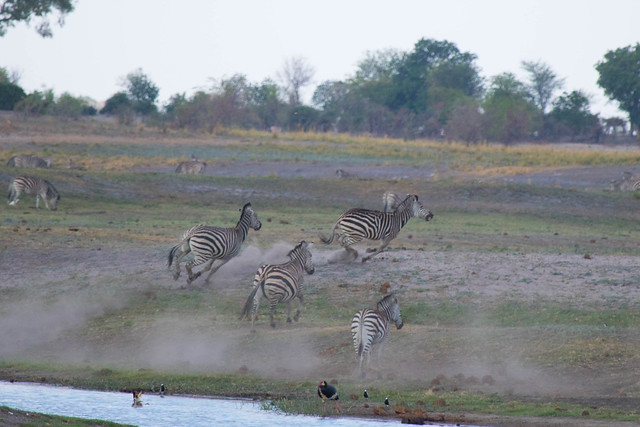
We moved on from the open plain, but stopped again when our guide spotted a tiny baby baboon. It was the first time I learned that even the guides are impressed by the wildlife – and when they are impressed by something, you know you are seeing something special.
Mike thought the baby was maybe just a day or two old. We watched him climb around his mama for a while.
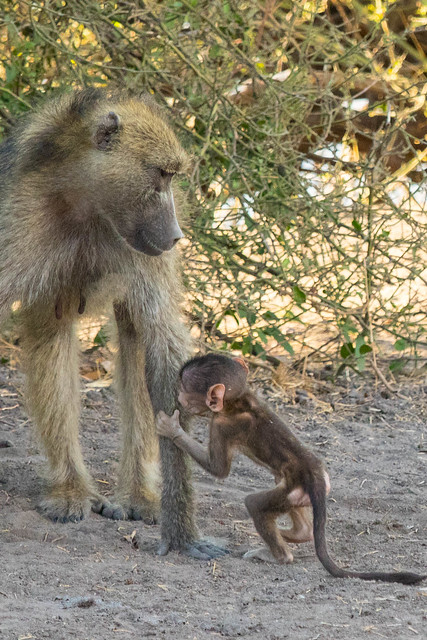
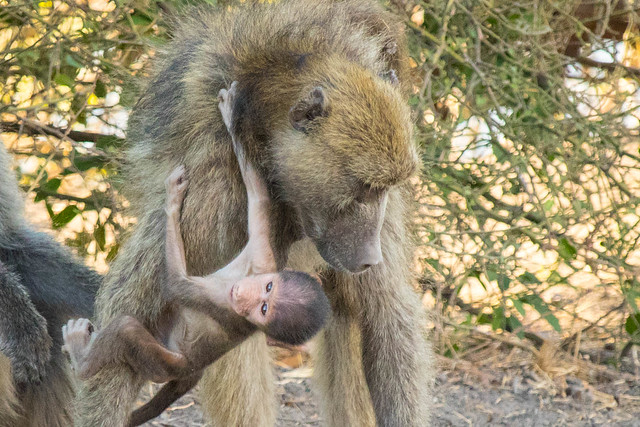
Next we found a group of giraffes. I think I squealed when we first saw them – so much for staying quiet around the wildlife!
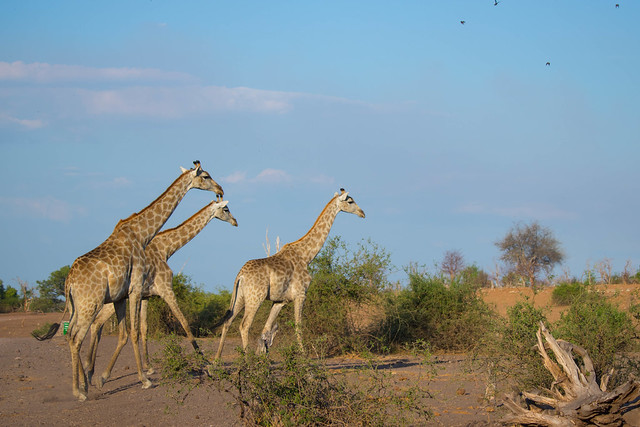
Finally, somehow Mike found some sleeping lions.
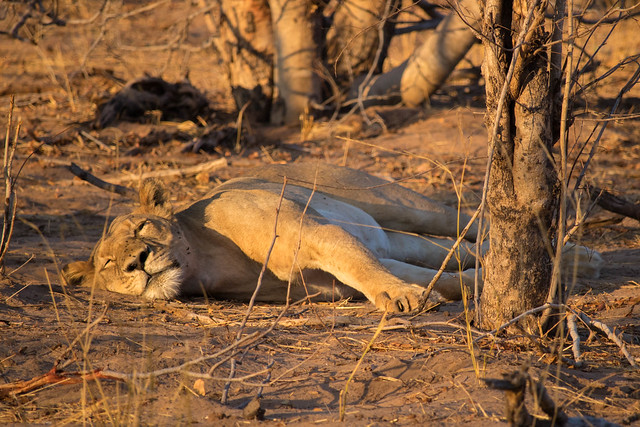
When they make a kill, the lions will gorge themselves, nap not too far away, then return to the carcass to gorge some more. We chose to do our “sun-downer” in the truck and wait to see if the lions would get up and return to their downed water buffalo. The gamble paid off, and before too long, one of the young lions got up.
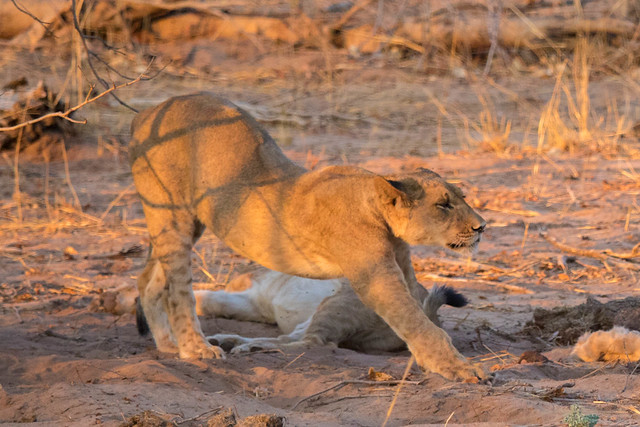
After pestering her mom, she decided to go to the carcass by herself. She didn’t need anyone else to pull the carcass over.

Then the other young lion joined her, and finally the two grown ups.
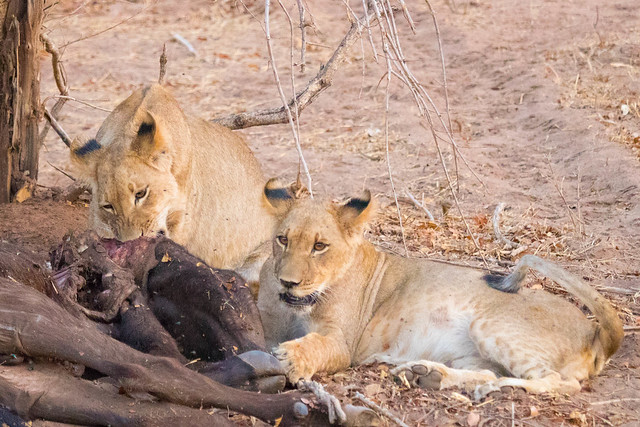
We stayed until we needed to speed out of the park before closing.
Tags: safari
Posted by barb on Nov 18, 2016 in
Pictures,
Recreation,
Travels For the most part, I’m not going to chronicle our transfers – after crossing into Botswana, our transfers were nearly all the same. However, getting from Zambia/Waterberry Lodge to Botswana/Chobe Elephant Camp was quite an adventure involving a van, a boat, and a couple safari trucks.
Our journey started in a van from Waterberry Lodge. We drove for about 45 minutes or so until we saw an imposing line of semi-trucks along the side of the road.
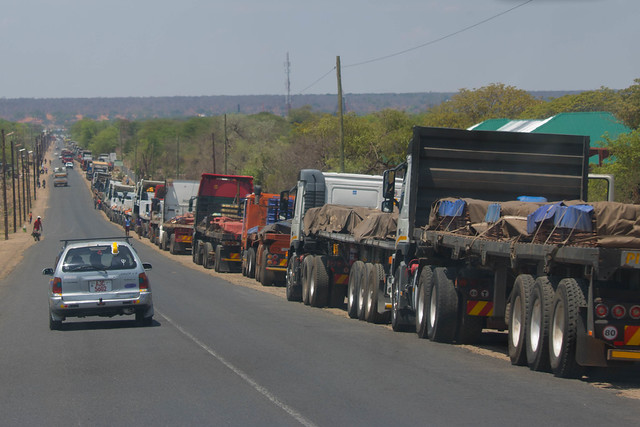
Our driver said that the line of trucks extended to the border river crossing, over a mile away. The river did not have a bridge crossing it, instead the trucks needed to wait for one of the available ferries. On a great day, there would apparently be three ferries running, but usually one or two were broken down. Often the drivers would need to wait a week to cross the river. In fact, a small economy had been built around this spot, with folks selling produce and necessary items to the truckers.

We approached the river crossing, and our driver passed us and our luggage on to a small boat to cross the river. From the boat, we could get a good look at the bridge that was being built. We were told that the existing bridge was constructed to help in building the final, public-worthy bridge. I wonder what will come of those little economies that have arisen once the bridge is completed.
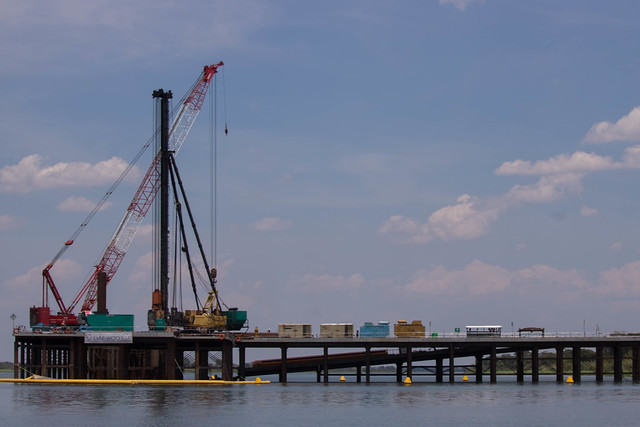
From there, we met up with another driver who would be taking us to meet with the Chobe Elephant camp representative. The driver shepherded us through the Botswana border crossing – even coming into the customs house to move us into the correct line. From there, we walked toward where the truck was parked; however, before officially crossing into Botswana, we had to step into a pan of water.
From there, we hopped into the truck (easier said than done, especially in an orthopedic boot – but I got used to it by the end of our trip).

This driver took us to the airport in Kasane, which is a common meeting point for exchanging safari tourists. We had to wait for about 10-15 minutes, but then a guide from Chobe Elephant Camp arrived to collect us.

From there, we drove through Chobe National Park – getting a taste for what we might see on our game drives later in our visit….
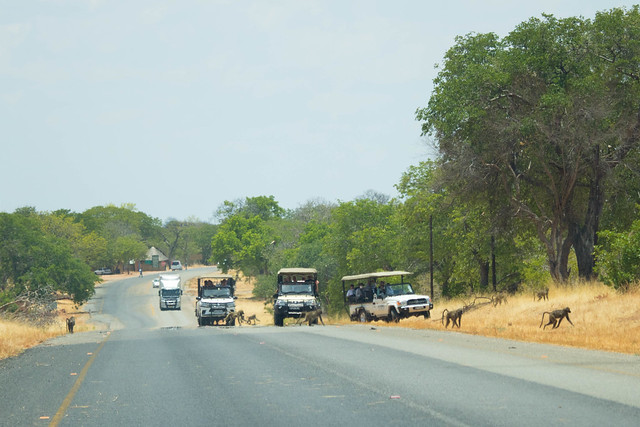


… including elephants!
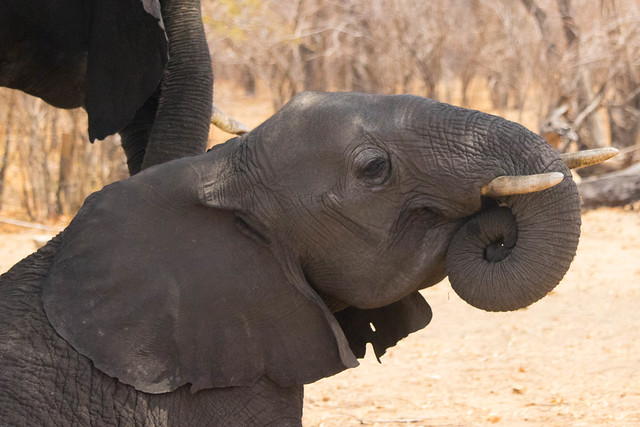

Tags: safari
Posted by barb on Nov 18, 2016 in
Pictures,
Recreation,
Travels On our first (and only) full day at Waterberry, we took the day trip to Victoria Falls. After breakfast, our guide for the day took us through Livingstone and on to the Zambia side of the Falls. He escorted us to the entrance, and took a minute to talk about the history of the falls and how the current falls are the fifth (?) falls throughout history as the river carves a new path. The he told us what to expect, mentioned with paths to take, and sent us on our way.
Along the path, we first found a statue of Livingstone overlooking the falls. We also had to keep an eye out for baboons on the way, but we weren’t carrying anything but our cameras, so they pretty much left us alone. (There was a warning in our room that asked ladies not to bring their purses because of the baboons!)

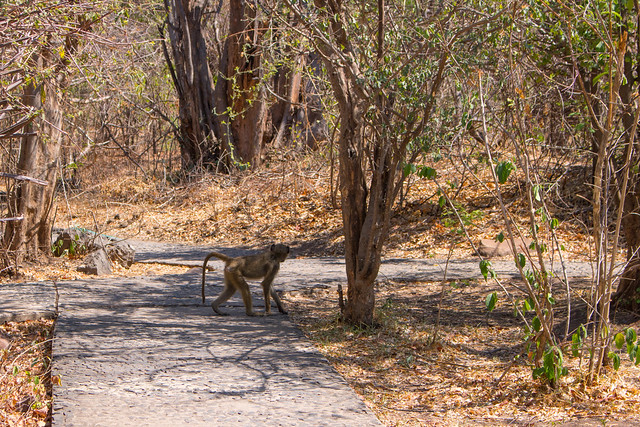
There wasn’t much of the falls to see from the Zambia side, since we were there during the dry season. Instead, there was a huge expanse of bare rock wall. We could only imagine what the falls would look like during the wet season. Reports are that you don’t actually see a lot during the wet season, because there is so much mist in the way.
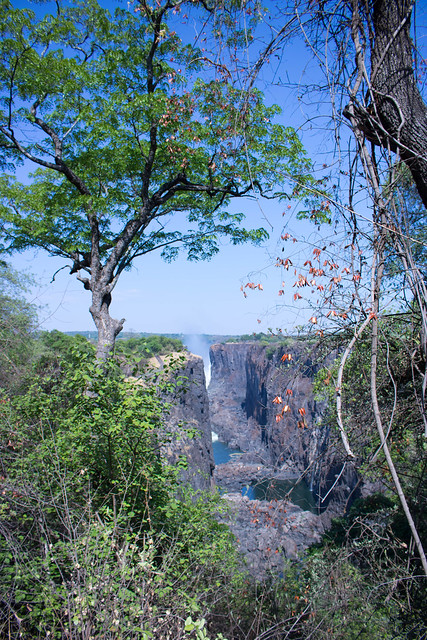
We crossed the knife-edge bridge to get to the very end of the Zambia side of the falls – it was where we could get the best view from Zambia. Still very little of the falls were visible.


We trekked back to the entrance, spent a little time at the market there, but left quickly after we decided that dickering wasn’t our thing!
Our guide then took us to the Zambia side of the border crossing and gave us instructions on how to get to the Zimbabwe side, how to cross the border, and where to find him when we returned. We decided to walk, rather than take a cab across – it was only a mile or so. However, it was *hot*!

After paying our visitor visa, we found our way to the Victoria Falls park. There were lots of paths that we could have taken, but since I was in my orthopedic boot, we decided to take basically the shortest path that showed the most of the falls.
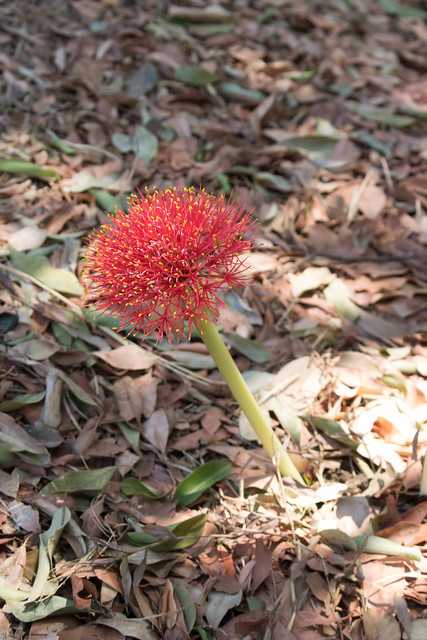
It was definitely worth the trip across the border, because we got to see actual water! From web searches, we determined that the water flow rate was about a third of Niagara, so we had certainly seen falls with more water. However, here, the falls are so much closer – they are essentially in a narrow canyon.
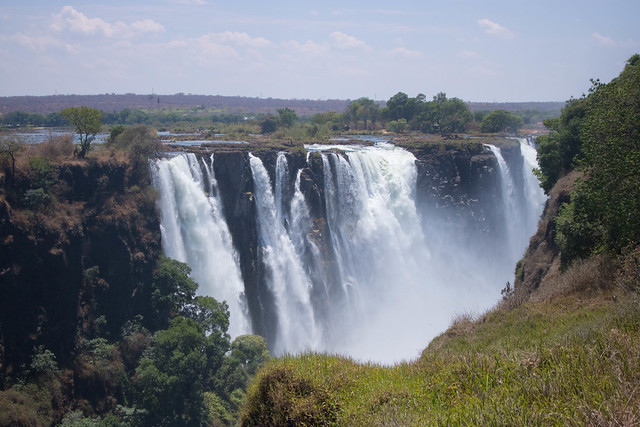
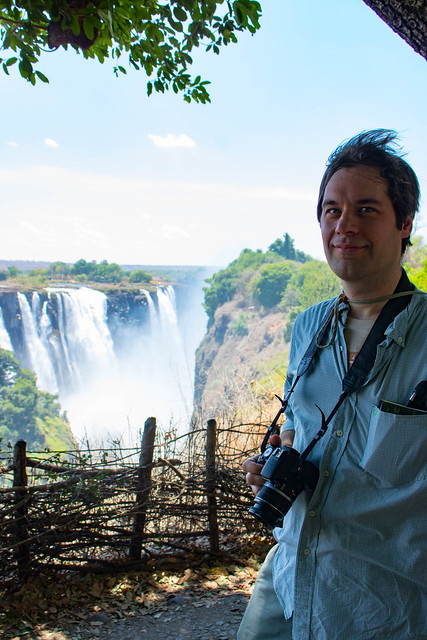
We popped into several observation spots to see the falls from as many vantage points as we could. At one point we even saw a group of people on the falls-side in Devil’s Hole – an experience to be right on the edge of the falls during the dry season. No thank you!

One thing that struck me was the barriers that they had erected on the edges of the path. In the US, we would have had concrete barriers with loads of signs and warnings. Here, there was just a bramble “fence”, and only at the places where the path led to the edge.
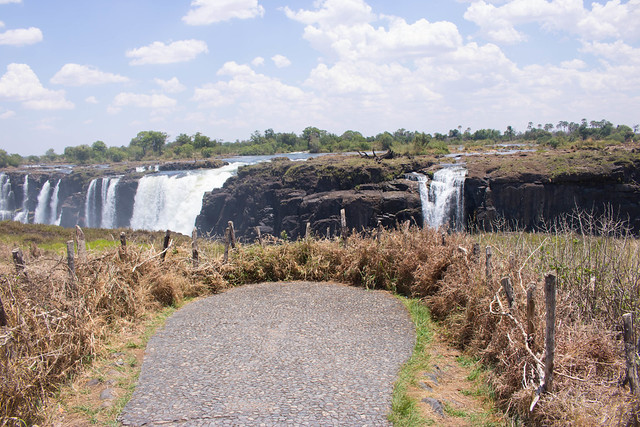

We finished and made our way back to our guide in Zambia (we used a cab to get across this time – much faster and less sweaty than walking). On our way back to the camp, we stopped and had a lunch that the camp folks had packed for us.
We had some time between returning to the camp and our planned sunset cruise in the evening. We sat on some chairs on the river bank (some distance from the river), and at one point spied some elephants across the river bathing.
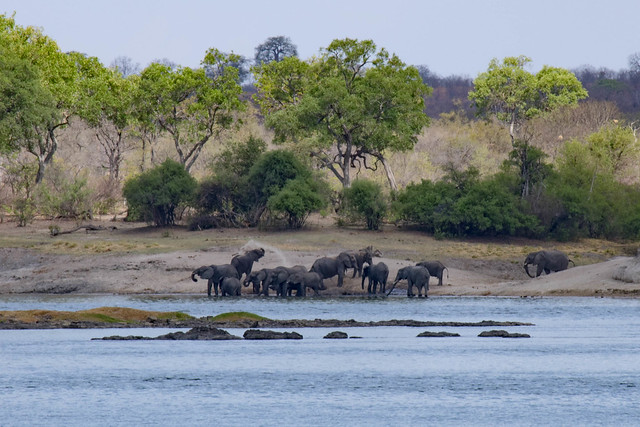
We took another river cruise, this time one highlight came after sunset. Our guide found a troop of baboons who were getting themselves ready for the night. The leader scouts out a tree, generally close to water. Then the troop grabs a drink, cleans each other, and starts to make their way up the tree. We got to see all of this.
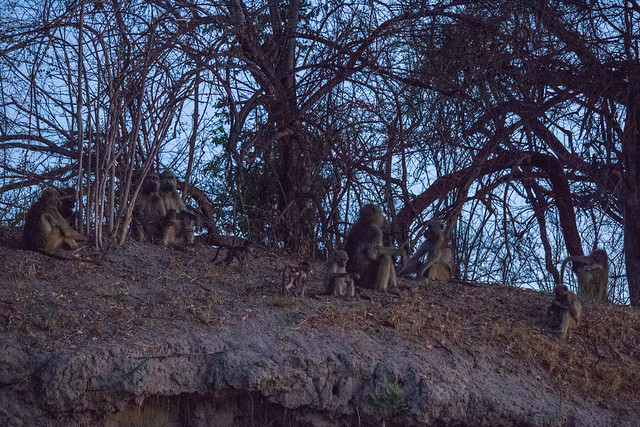
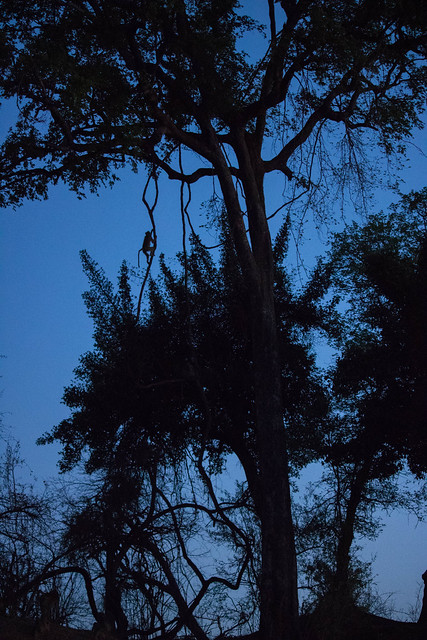
Before that, we also spied some zebra and a number of juvenile crocodiles. And for a while we followed a couple of water buck with their “friend” the cattle egret.
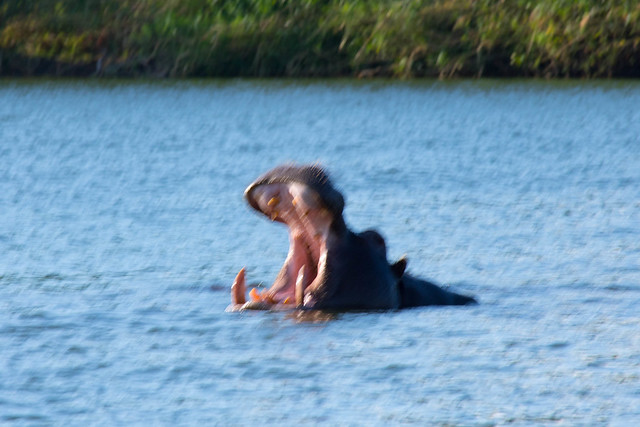
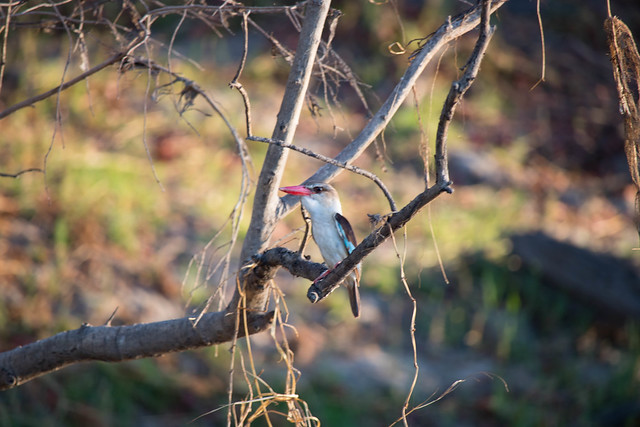
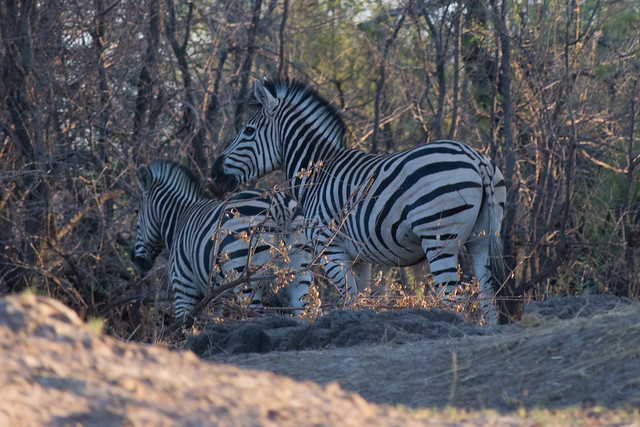
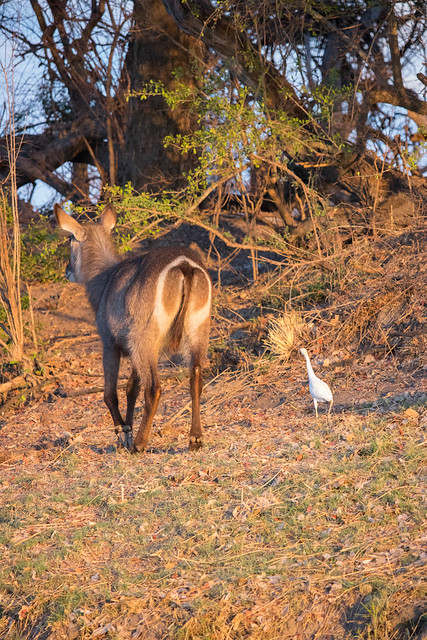
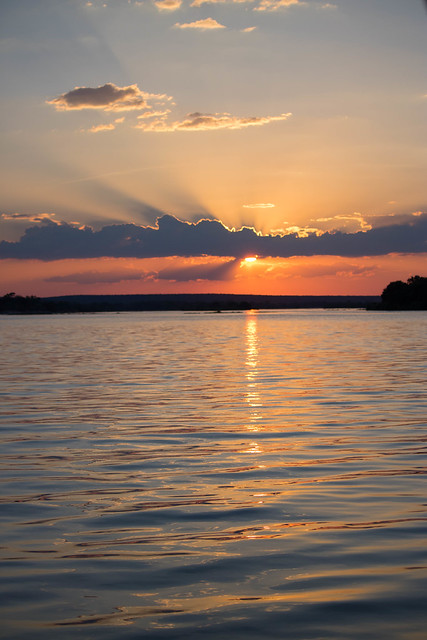
The next morning, we had one last experience at Waterberry before moving on to our next stop – we took a morning bird walk. I don’t remember many of the names or stories (not being a big birder), but we did enjoy the walk and seeing the birds.
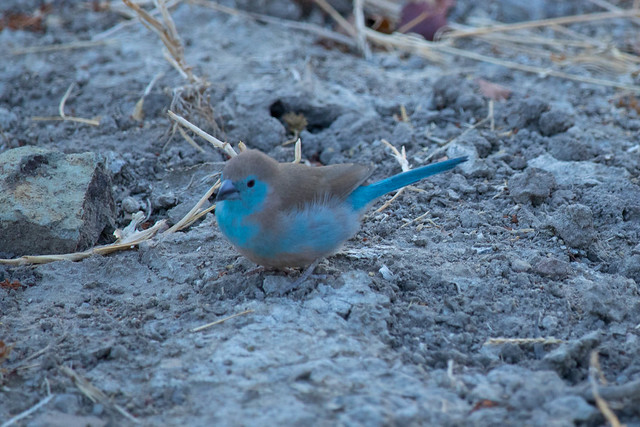
Tags: safari
Posted by barb on Nov 16, 2016 in
Pictures,
Recreation,
Travels I’ve dreamed of going on a photo safari since I was a little girl. My family had a membership to the Science Museum of Minnesota from the time I was in third grade until I was an adult. As a kid, I would page through their mailings, which included museum-sponsored trips in the back. Often there was a photo safari listed. I would read through the description and dream that I could go. This year was the year I would finally get to fulfill that little-girl’s dream.
Our trip started early on one of the longest days I’ve lived through – 1 hour drive to the airport, short flight to New York, 15.5 hour flight to Johannesburg, 2 hour flight to Livingstone (Zambia), 45 minute drive to our camp, plus all the layovers, time in security lines, and time in customs lines. By the time we reached our camp, we were exhausted, but it was only 1 PM local time, so we had lots of day left.
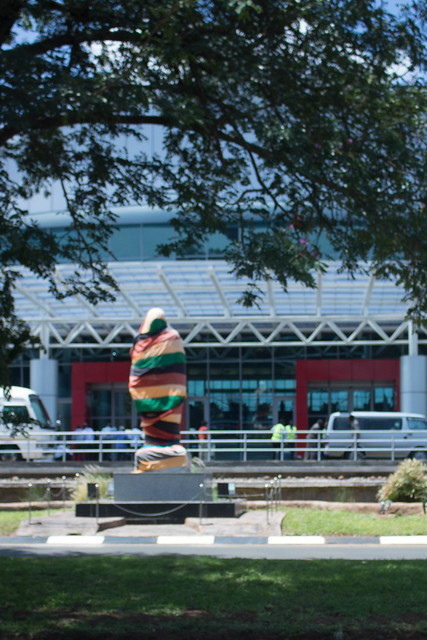
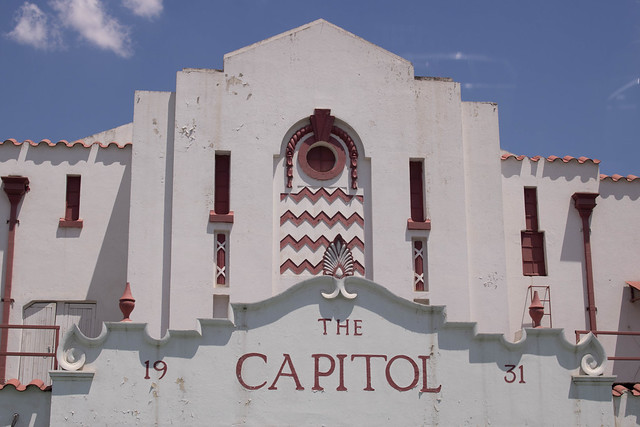
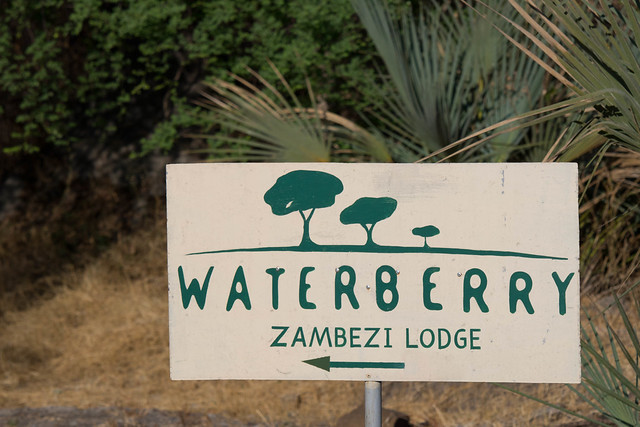
When we arrived at the camp, we were greeted with a (non-alcoholic) house drink and a safety briefing for the camp. This turned out to be standard at all the camps – both the drink and the briefing.

From there we were offered lunch and brought to our cabin and left to our own devices until our scheduled sunset river cruise. We took the opportunity to unpack a little, walk around the grounds, and relax. One thing we noticed immediately was the sound of hippos in the river. We chose this camp so that we could spend a day at Victoria Falls, not for its game, but we quickly learned that everywhere in Zambia and Botswana was close to wildlife – and big wildlife.
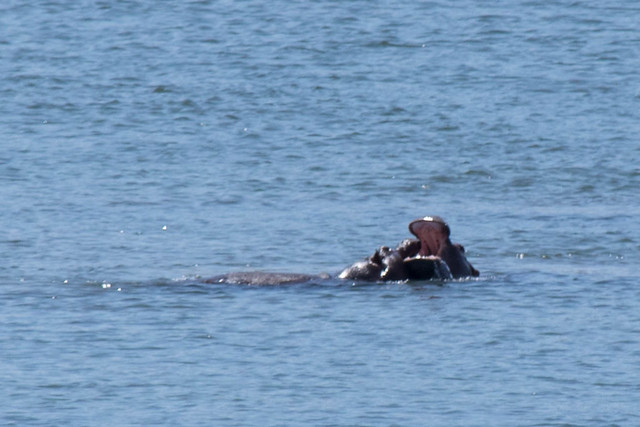
We took a short walk through their nature trail, sat on the side of a little lagoon, and found some baboons who didn’t like us disturbing them at all. It was fairly hot in the sun, so afterward we settled in the shade until it was about time for our river cruise.
We were struck by the volume of the cicadas at the camp. The noise level was similar (worse?) than when we had the Brood X cicadas in Maryland. If you turned your head the wrong way, the volume bordered on the pain threshold.
We weren’t sure what to expect on the river cruise, but we had heard that the land across the river – the Zambezi River – was a national Zimbabwe game reserve. And of course, we already knew about the hippos.
Within a few minutes of taking off, our guide pointed out a baby hippo grazing on some grass on a small rock outcropping. Her mama was nearby, keeping a constant eye on us. Our guide estimated that the baby was about 4 months old. The mama hippos keep the babies separate from the rest of the pod until they are about 6 months old. We also learned that baby hippos can nurse underwater!
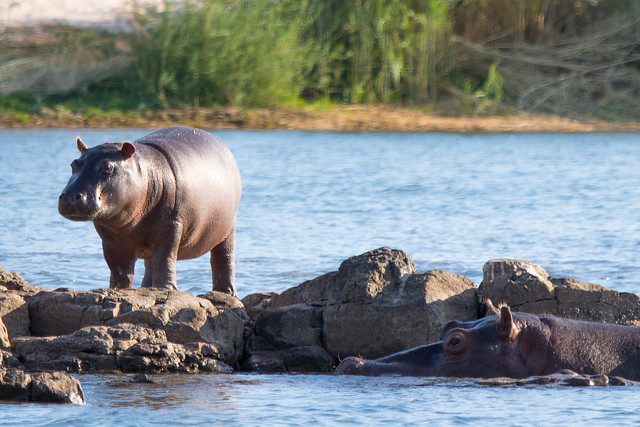
After watching them for a few minutes, we turned around and headed down river along the Zimbabwe side of the river. We found some impala, baboons, waterbuck, and crocodiles. We learned that the impala and baboons live together for part of the year, because the impala rely on the baboon’s higher vantage point to alert them to dangers. In addition, the baboons are messy eaters, so will drop things that the impala can eat. However, once the impala start having their babies, they separate from the baboons, because the baboons will kill and eat the baby impala.
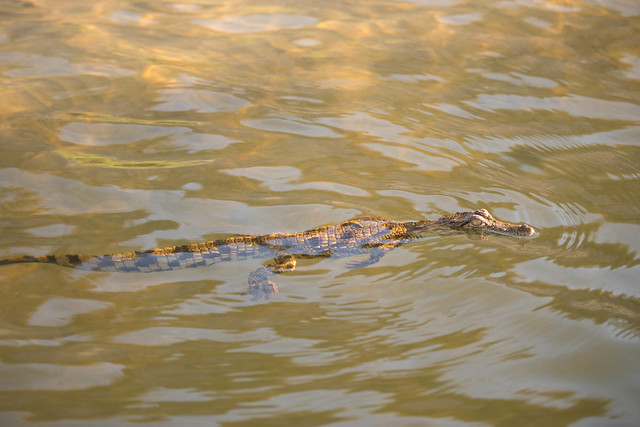
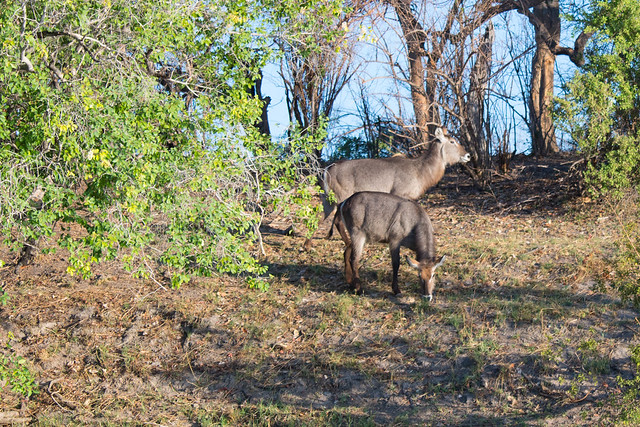
We stopped for drinks and a snack right around sunset and watched the sun go down. It seemed to sink very quickly!
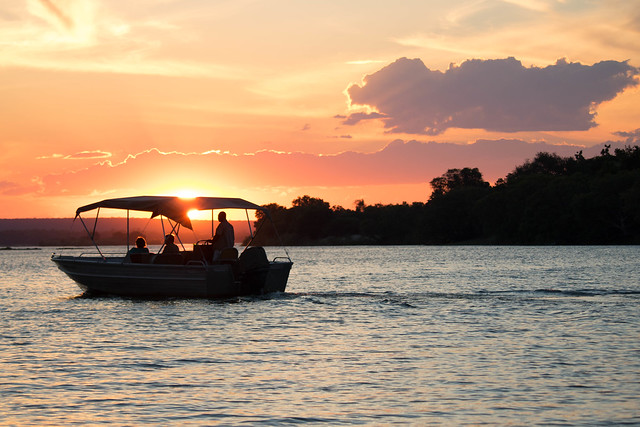
On our way back to the lodge, our guide spied the silhouette of a giraffe on the shore. He had told us that they came to shore to drink after sunset, and as if by magic, one appeared! I could barely make it out, but my camera has somewhat better eyes.
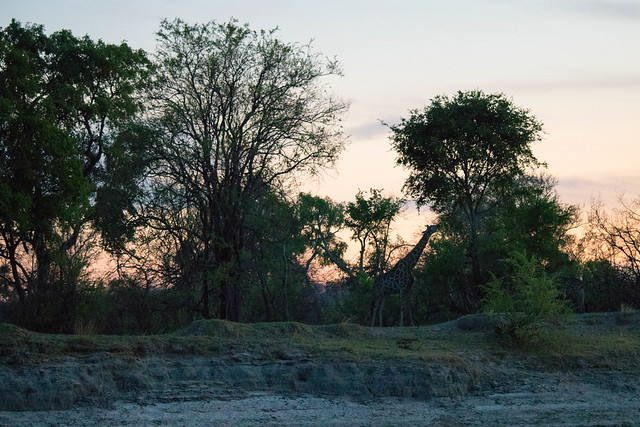
When we returned to camp, they had set up a private dinner for us on our balcony. This seemed like a lovely idea…until the cicadas took notice of our cabin’s light. They started dive-bombing us almost as soon as we sat down. We later realized that we probably should have turned off the light on our cabin and just relied on the candle on the table, but who knew? We made it through the appetizer and main course but I had to go back into the cabin before dessert. While dinner itself was lovely, the experience was not.
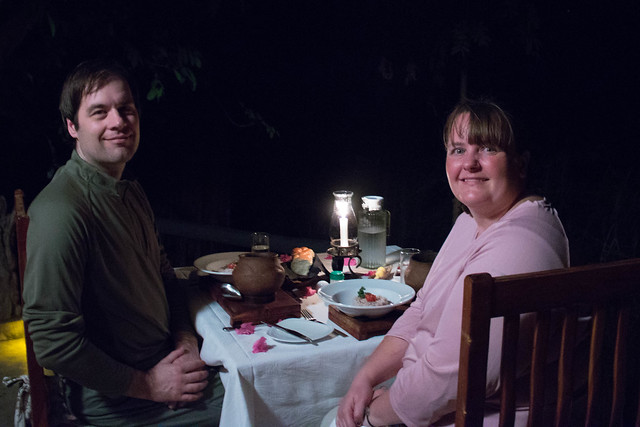

Tags: safari
Posted by barb on Mar 13, 2016 in
Around DC,
Recreation Last year we bid on, and won, a curator-led tour of the Sant Ocean Hall at the Smithsonian’s Natural History Museum during the National Zoo‘s Zoofari auction. And, today, we got to cash in our prize.
We arrived at the museum early so that we could have some time in the exhibit before the “hordes” arrived. We met Dr. Nancy Knowlton, a coral reef marine biologist and Sant Chair of Marine Science.
She and I had emailed a bit beforehand, and she had asked what kinds of interests our group had, so she could concentrate on those with her tour. Since we had all been through the ocean hall before, I suggested that she choose some of her favorite objects or objects with an interesting story.
After signing us in, Dr. Knowlton brought us to the entrance of the Ocean Hall. She took us to several things around the exhibit and we asked loads of questions. This included talking about cuttlefish camouflage, the Science on a Sphere, the coral reef aquarium, and the P-T extinction event.
A couple of the most interesting things we talked about were the fluid that the specimens are displayed in, the life in one square foot exhibit, shifting baselines, ocean positivity, and our behind-the-scenes look at the collections.
We stopped to look at one of the giant squid specimens, and Dr. Knowlton talked about the fluid that it is stored in. Originally, such specimens were kept in formaldehyde or alcohol. But, formaldehyde is toxic and that much alcohol in one place could destroy the museum if there was an accident. 3M created a different solution that wouldn’t be as dangerous. However, it turns out the solution is about three times more dense than water. When they put the solution in with the specimens, the specimens floated right up to the top! So, if you look closely at the specimens on display, there are cables and poles keeping them in place.
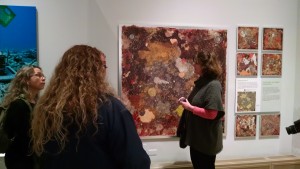
Dr. Knowlton had a chance to tell us more about her research when she took us back to the Life in One Cubic Foot temporary exhibit. She had developed a way to repeatably test the diversity of coral reefs. To do this, they place a stack of metal plates that’s about a cubic foot in volume. After about a year, they pick the stack up and catalog the large life within it. Then they scrape off the rest of the life and make a “smoothie” that they then identify the various DNAs present to get a catalog of life that’s present. The photographer that was involved in this project was inspired to look at what other life is in one cubic foot elsewhere in the world. This exhibit showcases some of those cubic feet.
We stopped in the fossil area to take our picture with the ancient shark jaws – a shark that makes a great white look like a guppy.
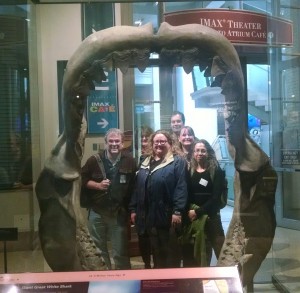
Then Dr. Knowlton brought us to a new education center at the museum – a center where they have a selection of the collection in drawers that visitors can look at, handle (in some cases), and get more information about. She showed us some of the ocean specimens behind the scenes collections at the museum, laboratory.
Finally, she took us back behind-the-scenes. Most of the collections have been moved off-site, due to the dangers of keeping that much alcohol and formaldehyde in one place. However, there are still a few things on the premises – we saw a huge bank of cabinets which held various plant life. She also brought us down to the lab where graduate students and postdocs work on identifying DNA strands of various animals.
To make the day’s adventures complete, we stumbled upon the St. Patrick’s Day parade in DC when we left the museum (on our way to the National Art Gallery to see the Greek Bronzes exhibition), so we stopped to watch.
